ASHEVILLESYMPHONY

ASHEVILLE SYMPHONY PROGRAM BOOK Fall 2022

2 ∙ www.AshevilleSymphony.org ∙ Fall 2022 Program Book The Best Relationships Start With Trust We work hard every day to go beyond what’s expected; to prepare the individuals and businesses we serve for whatever tomorrow might bring. Let us help you always be ready for what’s next. Personal | Mortgage Commercial | Business htb.com 220718-987275708

No need to pull strings… We are a full-service dentistry practice for everyone. Now accepting new patients! ASHEVILLEDENTAL.COM
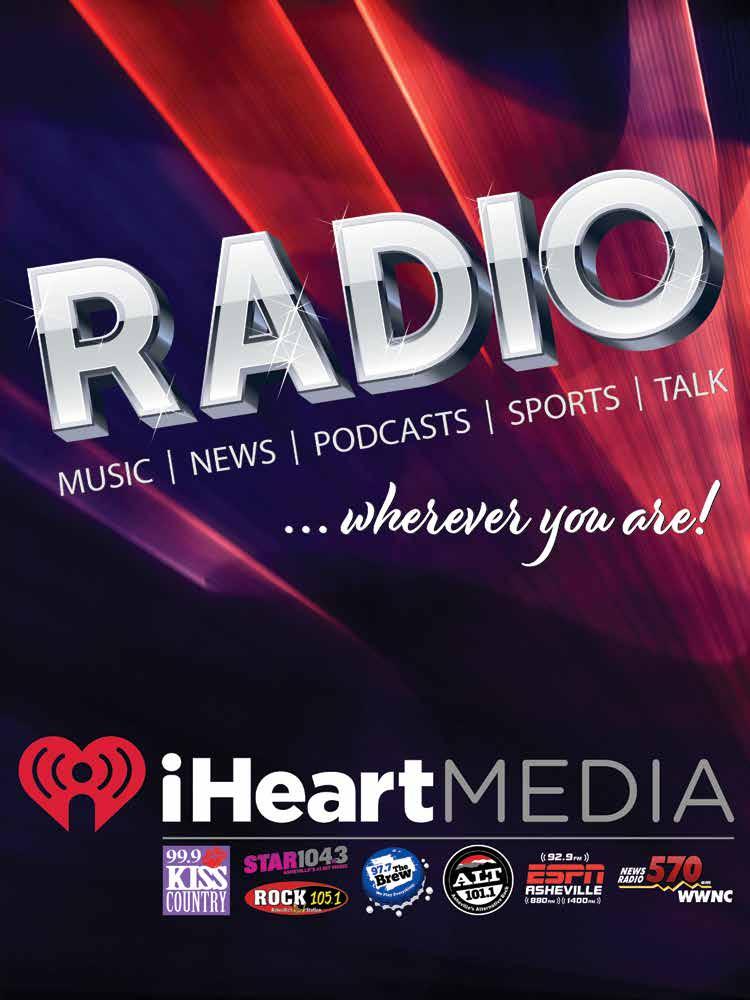
4 ∙ www.AshevilleSymphony.org ∙ Fall 2022 Program Book

Asheville Symphony ∙ www.AshevilleSymphony.org ∙ 5 KEEP IN TOUCH Asheville Symphony Office 27 College Place Suite 100 Asheville, NC 28801 Harrah’s Cherokee Center Asheville Box Office 87 Haywood St Asheville, NC 28801 828.254.7046 info@ashevillesymphony.org DONATE Mail or Visit 27 College Place Suite 100 Asheville, NC 28801 Phone 828.254.7046 Online AshevilleSymphony.org STAY SAFE, ENJOY THE MUSIC Please scan this QR code to learn more about our COVID-19 safety policies including masking and vaccination requirements. Contents Letter from Executive Director 7 Staff 9 Board of Directors 9 About the Cover 9 Past Presidents & Directors Emeritus 10 Letter from Board President 11 Music Director 13 Orchestra Personnel 14 ALT ASO @ Hi-Wire Brewing RAD Beer Garden · September 13, 2022 20 Masterworks 1: McGill & Mozart · September 17, 2022 22 ALT ASO @ Highland Brewing · October 4, 2022 28 Masterworks 2: Scheherazade · October 22, 2022 30 Masterworks 3: Night at the Opera · November 19, 2022 36 Interim Chorus Conductor 40 New Year’s Eve with 007 · December 31, 2022 42 Piano Recital with Evren Ozel · January 31, 2023 46 Asheville Amadeus Festival 52 Food & Beverage Partners 55 Season & Concert Sponsors 56 Donors 57 Asheville Symphony Chorus 58 Asheville Symphonettes 60 Asheville Symphony Guild 62 Asheville Symphony Youth Orchestra 64 Music Sponsors 66 Legacy Society 71 Advertisers Index 74
4M AVG MONTHLY PAGE VIEWS
64K
SOCIAL MEDIA FOLLOWERS
7 MINS
AVG MONTHLY TIME ON SITE
NOT TO BRAG...
...BUT OUR COMPETITORS DON’T EVEN COME CLOSE TO THESE STATS.
Based on this data, plus insights from our network of 155MM consumers, we create specialized digital marketing solutions that can help your business reach your customers right now.
Speak with your LOCALiQ marketing expert today, or get started at localiq.com/Asheville
6 ∙ www.AshevilleSymphony.org ∙ Fall 2022 Program Book
DANIEL M. CRUPI
Dear ASO friends and family,
If my experience in the arts has taught me anything – especially throughout the challenges of the last few years – it is that together, with creativity, vision, and hard work, we can accomplish the unthinkable. And, if I have learned anything about Asheville during my first year here, it is that this community proudly fosters an incredibly vibrant and resilient arts scene, and that it is eager to support more innovative work in this sector.
With that in mind, we have crafted an ambitious and exuberant 2022-2023 Asheville Symphony season for you, filled with exciting new initiatives and reimagined takes on the classics, as well as the triumphant return of the Asheville Amadeus Festival.
The 2022-2023 Masterworks Series returns to full force with seven extraordinary concert programs, featuring composers ranging from Ludwig van Beethoven and Antonin Dvořák to Fazil Say and Jessie Montgomery. Our New Year’s Eve concert tradition continues in style with the music of one of the world’s favorite film franchises – Bond, James Bond – and we also continue to present an intimate Piano Recital showcasing rising talent on the national scene.
Our new and regularly sold-out ALT ASO series is expanding, growing to a fourconcert series in yet more iconic Asheville venues, including Hi-Wire Brewing’s RAD beer garden, Highland Brewing, The Orange Peel, and Salvage Station’s outdoor stage on the banks of the French Broad River.
The Asheville Amadeus Festival also makes a long-awaited return, this year exploring every facet of American music – and featuring banjo superstar, Béla Fleck, as the festival headliner! In addition to performing his acclaimed The Imposter Concerto with the ASO at the Festival’s grand finale, Béla’s week-long residency in Asheville will include a diversity of partners and, of particular note, feature a Young People’s Concert with the ASYO for every 5th-grader across our city and county. Altogether, this year’s Festival will feature more than 50 events from dozens of organizations across Western North Carolina – stay tuned for more details!
Last but certainly not least, we open our entire season with the return of our Symphony in the Park concert in downtown’s Pack Square Park, where we endeavor to unite our community and uplift our entire region in a free, collaborative performance for an audience of thousands.
We have big plans for the Asheville Symphony. We all envision an inclusive and representative orchestra that radically engages its community, showcases a diversity of musical interests and perspectives, prioritizes the education of the next generation, and achieves the highest of artistic standards. With your help, we can make this vision a reality.
Thank you for your generous support for the Asheville Symphony – we look forward to seeing you this season!
Warm regards,
Daniel M. Crupi Executive Director

Asheville Symphony ∙ www.AshevilleSymphony.org ∙ 7
Executive Director







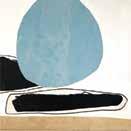





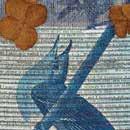
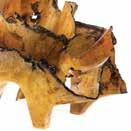

8 ∙ www.AshevilleSymphony.org ∙ Fall 2022 Program Book 38 BILTMORE AVENUE DOWNTOWN ASHEVILLE 828.251.0202 BLUESPIRAL1.COM WITH EACH VISIT, AN OPPORTUNITY TO BE INSPIRED.
Board of Directors & Staff
OFFICERS
Michael Andry • President
Sue Luther • President Elect
Dr. Bolling Farmer • Past President
John W. Ellis • Secretary
Ed Towson • Treasurer
DIRECTORS
Jack Anderson
Michael Andry
Mr. Thomas C. Bolton
Sallie T. Broach
Dr. Nancy J. Cable
Dr. John Cuellar
George Dambach
John Donahoe
John W. Ellis
Lynne Eramo
Dr. Bolling Farmer
Betty Fox
Adarrell Gadsden
Bill Gettys*
Debbie Green
Fred Groce
Stan Ingber
Mary Kirby
Gerald Kitch
Pamela Lowe-Hoyte
Sue Luther
Elizabeth McCorvey
Carol McCollum*
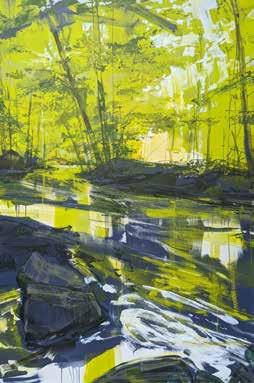
Patrick O’Cain
Jeffrey Owen
Irene Stoll
James S. Thompson
Sandra Tompkins
Ed Towson*
Sarah Van Gunten
Olivia Zahler
ASHEVILLE SYMPHONY STAFF
Jessica May Director of Development
Madeline Womack Development Manager
Sally J. Keeney
Sherry Blakely Controller
Hannah Williams Patron Services & Office Manager
YOUTH ORCHESTRA STAFF
Cynthia Roop General Manager
Alexandra Dee Symphony Conductor
Amanda Tant Chamber Conductor
Ashlee Booth Prelude Conductor
Brian Tinkel Percussion Director
Dilshad Posnock Woodwind Coach
Franklin Keel Strings Coach
828.254.7046 info@ashevillesymphony.org
27 Colllege Place Suite 100 Asheville, NC 28801

(continued on next page)
ABOUT THE COVER
Jeremy Russell is a contemporary abstract expressionist based in Asheville, NC. “My work is more influenced by music than visual art. Specifically, classical and jazz. I embrace the very same intuitive spontaneity that musicians harness in the heat of improv. Of course, there is a foundation of observation and accuracy in the landscape paintings to which I honor the energy of the natural places where I meditate. Like the complex compositions of a composer, a strong painting evolves through a harmonious push and pull between a foundational constant and all the variables and vibrations that surround that base subject. Regarding my interest in painting, I reference the incredible symphony of all the parts experienced at a location — The movement of light, the flow of water, the sounds of life, the presence of the divine.”
Asheville Symphony ∙ www.AshevilleSymphony.org ∙ 9
Jason Posnock Advisor
SELECTED IN COLLABORATION WITH
“GREEN MORNING ON THE PIGEON RIVER” Acrylic on canvas, 72 x 48 in.
CONTACT
*Distinguished Directors
Daniel M. Crupi Executive Director
Orchestra Manager
Mary Ellen Dendy Marketing Strategy Consultant
Claire M. Allen Marketing Manager & Creative Director
Michael Di Trolio Principal Librarian
for viewing and purchase at
Paul Stroebel Stage Manager
Available
Blue Spiral 1 with a portion of the proceeeds to benefit the Asheville Symphony.
PAST PRESIDENTS
1962-1964: Gaylord Davis
1964-1966: Rudolf Gumpert
1966-1968: John W. Rutland
1968-1970: Robert K. Weiler
1970-1971: Robert Saenger
1971-1972: William C. Spencer, Jr.
1972-1975: John K. Knight
1975-1977: Lawrence D. Ford
1977-1979: Mortimer Ryon
1979-1982: James E. Dooley
1982-1984: J.K. MacKendree Day
1984-1985: George Saenger
1985-1987: Spencer Atwater, MD.
1987-1989: George Goosmann, III
1989-1992: John J. Sherman, Jr.
1992-1994: G. Edward Towson, II
1994-1995: Stephen L. Barden, III
1995-1997: Joyce R. Dorr, Ph.D.
1997-1999: C. David Pheil
1999-2001: George M. Bilbrey, MD.
2001-2003: W. Herbert Smith, Jr.
2003-2004: James P. Topp
2004-2006: Thomas C. Bolton

2006-2008: Carol McCollum
2008-2010: Jack Anderson
2010-2012: Carolyn L. Hubbard
2012-2014: William L. Gettys
2014-2017: Irene Stoll
2017-2019: Doris Phillips Loomis

2019-2021: Bolling Farmer
DIRECTORS EMERITUS
George M. Bilbrey, Jr. M.D.*
J.K. MacKendree Day
Joyce R. Dorr, Ph.D.
Karl S. Quisenberry, Ph.D.*
John J. Sherman, Jr.
W. Herbert Smith, Jr.
10 ∙ www.AshevilleSymphony.org ∙ Fall 2022 Program Book
Board President
MICHAEL ANDRY
Dear Asheville Symphony friends and family,


The Asheville Symphony has a wonderful year planned for you. We made it through the COVID reopening year and are now moving full steam ahead toward a bright future! While we continue to offer our traditional Masterworks series and our New Year’s Eve programming, this year also marks the expansion of our ALT ASO series and the return of the Asheville Amadeus Festival. We will also continue producing our annual gift to the community with our public Symphony in the Park concert, in Pack Square, as the season opener in late August.
This year should be especially fun, with the orchestra showcasing Beethoven to Brahms to Bach to Béla Fleck. We continue to embrace our entire community with concerts from Salvage Station to Highland and Hi-Wire Brewing. Your Asheville Symphony now reaches over 30,000 patrons and 6,000 youth in our community. We cherish our place in representing the great classical repertory as well as the new ideas and programs that are continuing to drive this organization forward.
None of this could be possible without the support of you, our customers. We would also like to thank our donors once again – none of this would be possible without you. Finally, thank you to our wonderful business sponsors; please join me thanking them by patronizing their businesses, and often!
From the entire Board and Staff, I thank you for being here – and now, please sit back and enjoy the show.
Michael Andry Board President
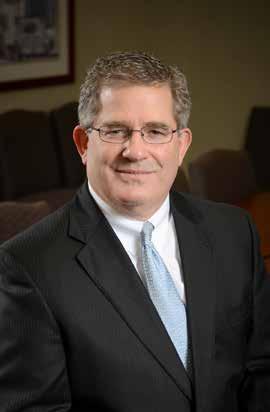
Asheville Symphony ∙ www.AshevilleSymphony.org ∙ 11
SETTING THE STAGE FOR BEAUTIFUL MEMORIES
A love of the arts and a sense of hospitality inspired George Vanderbilt’s masterpiece: Biltmore.

Share in that legacy today by joining our Annual Passholder family.
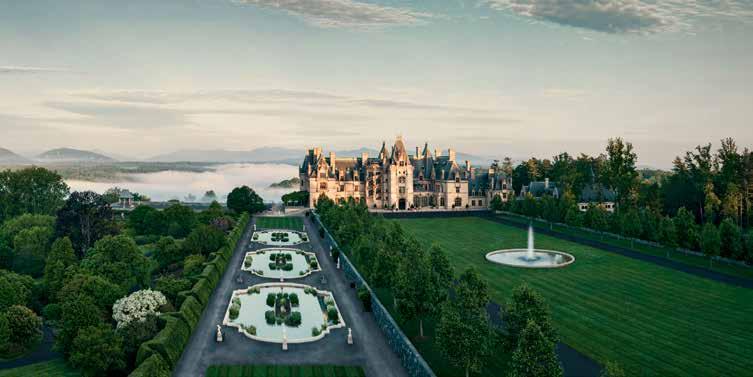
12 ∙ www.AshevilleSymphony.org ∙ Fall 2022 Program Book
BILTMORE.COM/JOIN
ASHEVILLE, NC
Praised by the Westdeutsche Zeitung for his “exceptional combination of passion, elegance and well-timed pacing”, Darko Butorac has established himself as a conductor in demand with orchestras both in Europe and the Americas. He currently serves as the Music Director of the Asheville Symphony and the Tallahassee Symphony Orchestra.
Following his debut with the Belgrade Philharmonic in January 2011, Butorac was reengaged to conduct both the season finale and the opening concert of the 2012 season. Other notable guest conducting engagements include performances with
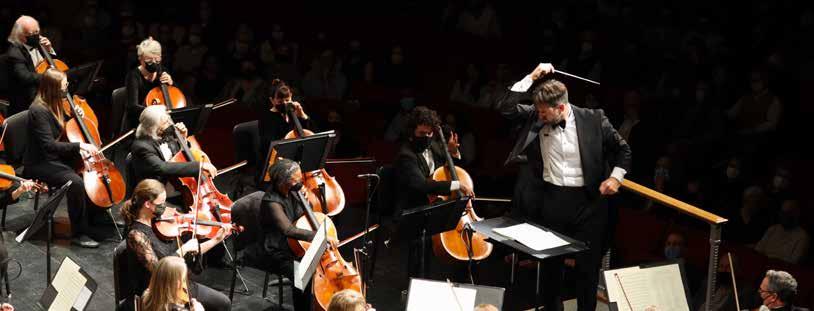
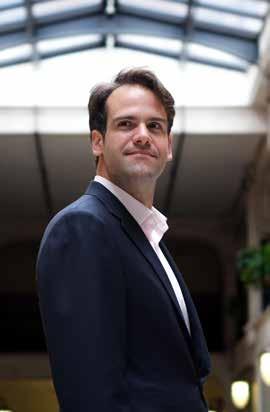
Music
DARKO BUTORAC
the Deutsche Kammerphilharmonie Neuss and the Georgische Kammerorchester Ingolstadt (Germany), the Rubinstein Philharmonic of Lodz (Poland), the Xiamen Symphony (China), the Tallinn Sinfonietta (Estonia), and the Slovenian Radio Symphony Orchestra. He has appeared at such prestigious venues as the Vienna Konzerthaus, the Gran Teatro Nacional of Lima, Belgrade’s Kolarac Hall, the Teatro Magnani in Italy, and the Tartu, Aspen and St. Olav summer music festivals. From 2009 to 2013, he served as the principal conductor of the Fidenza Opera Festival.
Distinguished collaborations include soprano Renee Fleming, pianists Garrick Ohlsson and Jon Kimura Parker, tenor Lawrence Brownlee, cellist Colin Carr, clarinetist Anthony McGill, and Oscarwinning actor J.K. Simmons among others. Highlights of the 2021-22 season include performances with pianists Aaron Diehl and Stewart Goodyear, violinists William Hagen and Blake Pouliot, cellist Jamal Aliyev, and a New Year’s Eve gala with vocalists Morgan James and Erica Gabriel.
Butorac helped his orchestras emerge from the pandemic by creating programs featuring over 75 short works for chamber orchestra formations, with a focus on presenting works by underperformed composers and minorities. The Tallahassee Symphony was one of the first orchestras in the United
States to move to a fully virtual format, by committing to webcasting live performances in April of 2020.
As the Grand Prix Laureate and Gold Medalist of the Fourth International Vakhtang Jordania Conducting Competition, Butorac was invited to conduct orchestras across four continents. He was also selected to participate at the Bruno Walter National Conductor Preview hosted by the League of American Orchestras and the Jacksonville Symphony.
Butorac served as the Music Director of the Missoula Symphony from 2007-2019, marking a period of tremendous artistic growth of the orchestra. He challenged the ensemble with a broader repertoire leading to greater engagement with the community and frequently sold-out performances.
Butorac is also in demand as a public speaker on leadership. His TEDx Montana talk on the “Language of Conducting” has over a 150K views on YouTube. He has appeared as a speaker on behalf of Brighthouse, a division of BCG, and was the headline speaker at the Birla Carbon International Leadership Summit in Bangkok in 2018.
He is an avid traveler, having visited almost seventy countries, and is passionate about discovering the world and bringing people together through the beauty of music.
Asheville Symphony ∙ www.AshevilleSymphony.org ∙ 13
Director
VIOLIN
Jason Posnock • Concertmaster
Martha Gardner • Associate Concertmaster
Open Chair • Assistant Concertmaster
Kathryn B. Gardner • Principal Second Violin
Debra L. Anthony Associate Principal Second Violin
Marianna Brickle
Teresa M. Curran
Elizabeth Fee-Elliott
Lori G. Hammel
Rachael Kistler-Igo
Dorothy L. Knowles
Virginia Kowal
LuAda Malcom
John R. Malloy
Ruben Orengo
Mariya S. Potapova
Inez Hullinger Redman
Essena Setaro (loa)
*Paul E. Stroebel
VIOLA
Kara F. Poorbaugh • Principal
Emily Schaad • Associate Principal
Leigh Dixon (loa)
Martha L. Geissler
Gina Mashburn Heath
Jennifer Kozoroz
Karen Pommerich
Edward J. Smith
CELLO
Daniel Mumm • Principal
J. Franklin Keel • Associate Principal
Open Chair • Assistant Principal
Cherylonda F. Fitzgerald
Paul S. GhostHorse
Katie Hamilton
Patricia Koelling Johnston
BASS
*M. Lee Metcalfe • Co-Principal
Vance M. Reese • Co-Principal
Michael Di Trolio
Matthew P. Waid
Orchestra Personnel
FLUTE
Lissie J. Shanahan • Principal
Kellie Henry
PICCOLO
Dilshad B. Posnock
OBOE
Alicia Chapman • Principal
*Cara Mia Jenkins
ENGLISH HORN
Amanda J. LaBrecque
CLARINET
Harry H. “Chip” Hill • Principal
Karen Farah Hill
BASS CLARINET
Shannon Thompson
BASSOON
Michael J. Burns • Principal
Amber Ferenz Spuller (loa)
CONTRABASSOON
William L. Peebles
HORN
Jeffery B. Whaley • Principal
*Michael L. Brubaker
Anneka A. Zuehlke
Travis A. Bennett
TRUMPET
T. Mark Clodfelter • Principal
P. Bradley Ulrich (loa)
Christopher Underwood
TROMBONE
Open Chair • Principal
L. Rienette Davis
BASS TROMBONE
Jeremy Marks
TUBA
Bethany Wiese • Principal
TIMPANI
Todd D. Mueller • Principal
PERCUSSION
Caleb Breidenbaugh • Principal
Matthew Richmond
*Brian Tinkel
Michael Morel
HARP
Open Chair • Vetust Study Club Chair
KEYBOARD
Open Chair • Susanne Marcus Collins Chair
Supporting Our Musicians
INSTRUMENT ENDOWMENT
Your support of the Asheville Symphony Society’s endowment is the ticket to a secure, stable financial future for your Symphony. Consider endowing your favorite instrument in perpetuity! To learn more about endowment, please contact the ASO's Director of Development Jessica May at 828.318.8181 or jcmay@ashevillesymphony.org.
MUSICIAN RESILIENCY FUND
The ASO Musician Resiliency Fund ensures that the Asheville Symphony can continue to attract the best orchestral talent and compensate its musicians competitively within the region. Thank you to those who support this fund:
Richard Schaffer and Anastasia Bartlett
Michael and Catty Andry
Dr. Bolling Farmer
Jim and Mary Kirby
Hugh and Carol McCollum
Irene and Michael Stoll
Michael Di Trolio • Principal Librarian
Paul Stroebel • Stage Manager
* Orchestra Committee Member
Section string players are listed alphabetically.
(loa) = Leave of Absence
14 ∙ www.AshevilleSymphony.org ∙ Fall 2022 Program Book

Asheville
∙ www.AshevilleSymphony.org ∙ 15
Symphony
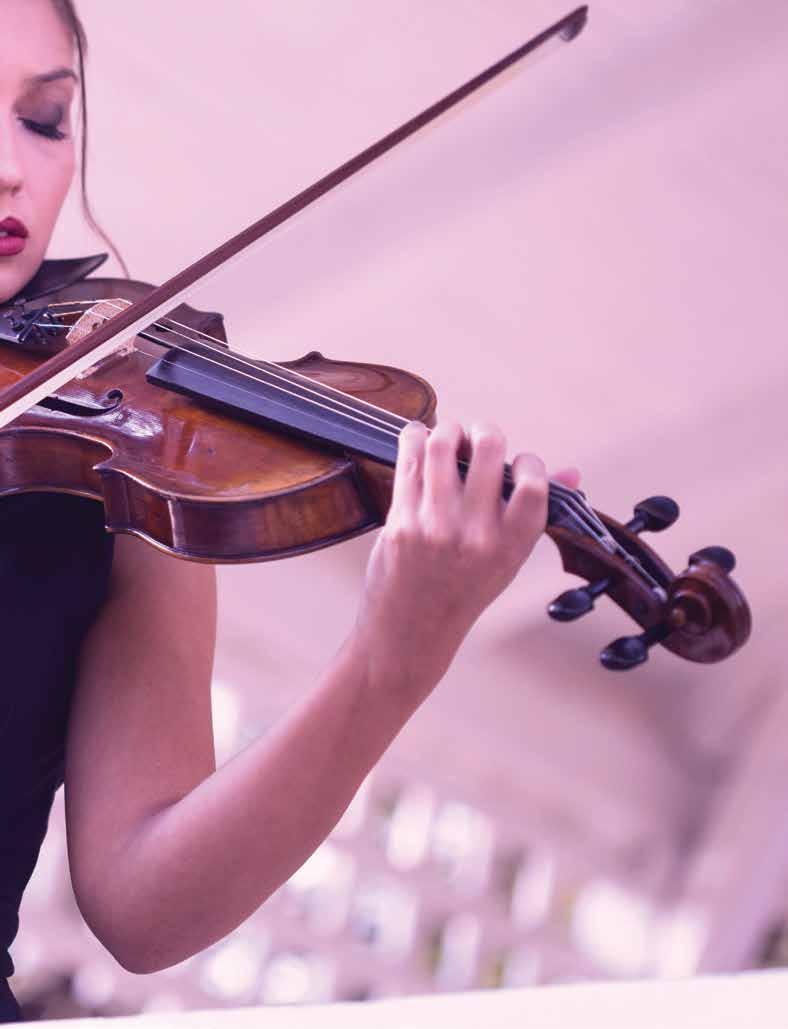
Proud supporter of the Asheville Symphony Society and its continuous commitment to the people of Western North Carolina. mwblawyers.com 828.254.8800 CRESCENDO.
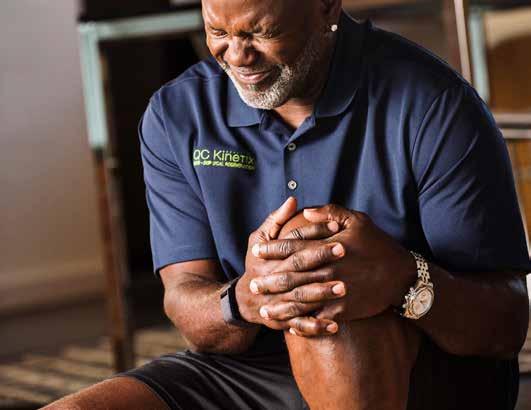


Asheville Symphony ∙ www.AshevilleSymphony.org ∙ 17
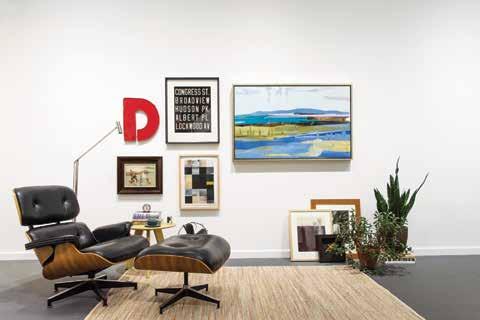


18 ∙ www.AshevilleSymphony.org ∙ Fall 2022 Program Book frugalframer.com Downtown AVL/Montford | 95 Cherry St. North | 828.258.2435 South Asheville | 200 Julian Shoals Dr. #20 | 828.687.8533 Full Service Accounting & Consulting for Individuals & Businesses 828.274.5524 59 Turtle Creek Dr. www.crawleyleeandco.com
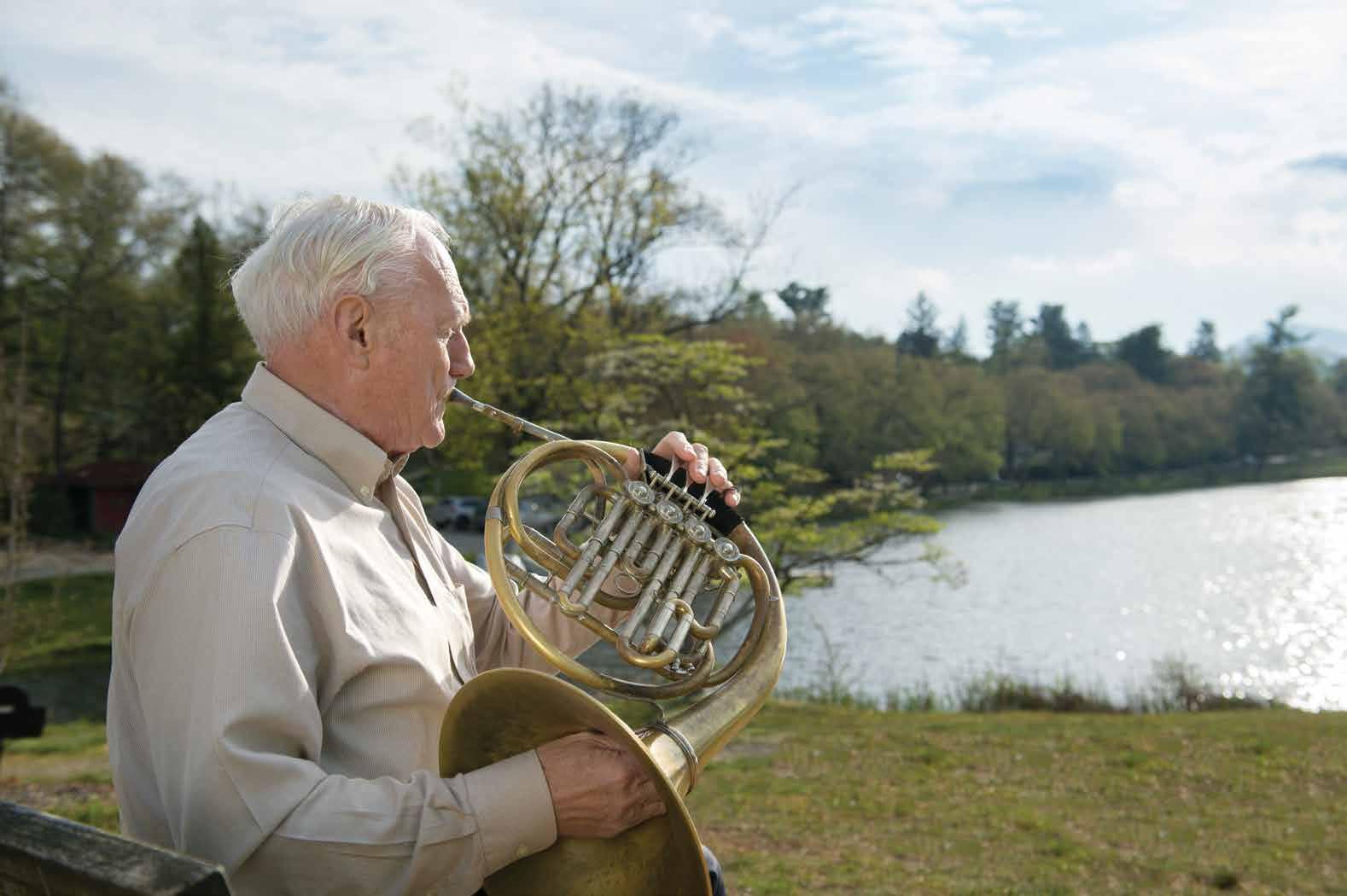
Asheville
∙ www.AshevilleSymphony.org ∙ 19
Symphony
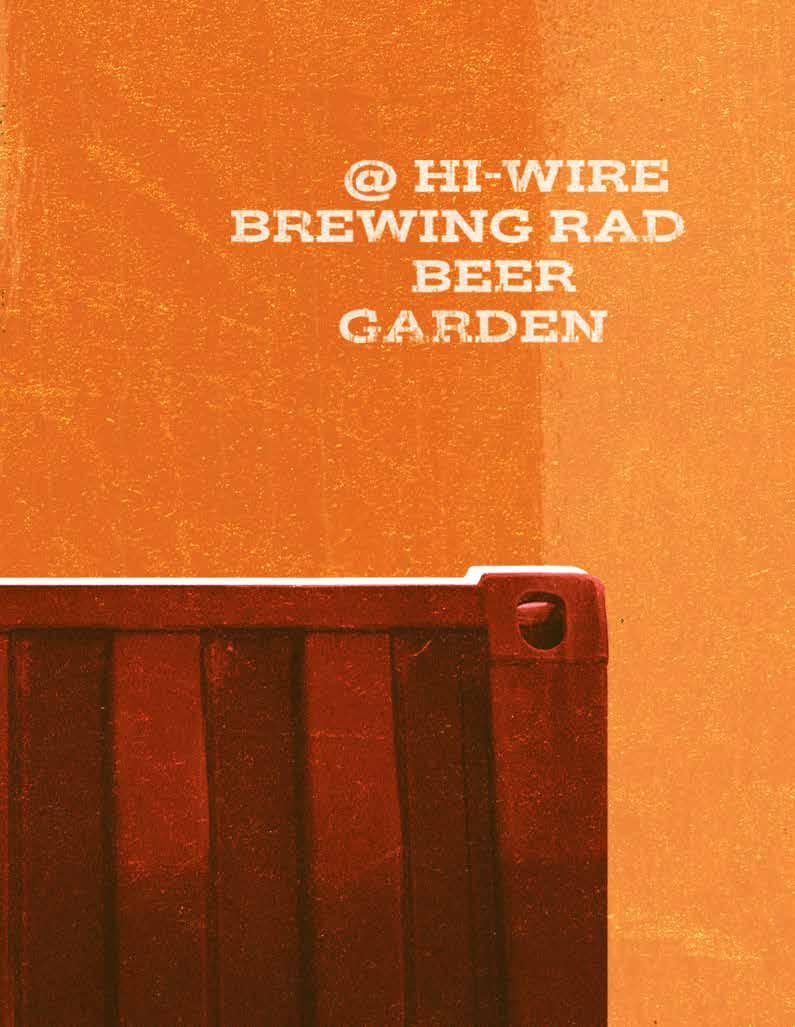
20 ∙ ALT ASO @ Hi-Wire Brewing RAD Beer Garden
ALT ASO @ HI-WIRE BREWING RAD BEER GARDEN


Darko Butorac, Conductor
We kick off the 2022-2023 season Opening Week at Hi-Wire Brewing’s third Asheville location: its new beer garden. Encircled by repurposed shipping containers, this indoor-outdoor taproom opened in 2021 in Asheville’s River Arts District. This performance features a hybrid New Orleans jazz band and Balkan brass band, creating a celebratory atmosphere for our season opener and featuring toe-tapping repertoire including Bourbon St. Parade, When the Saints Go Marching In, and more!
TUESDAY, SEPTEMER 13, 2022


7:00 P.M.
AMBER SPONSORS



Henry A. LaBrun
BOHEMIAN SPONSORS


Craig Allen & Julie Cowden

Asheville
∙ www.AshevilleSymphony.org ∙ 21
Symphony
Many thanks to the Preservation Hall Foundation for providing transcriptions of the New Orleans brass band repertoire featured on this program
OFFICIAL AUTOMOTIVE COMPANY OF THE ASHEVILLE SYMPHONY
SERIES PRESENTING SPONSOR
Kevin Pasarilla & Jennifer Marlowe
MASTERWORKS 1

Thomas Wolfe Auditorium
Saturday, September 17, 2022, 8:00 p.m.


We open our 22-23 season with the spirit of virtuosity. Montgomery captures the energy of young virtuosos with Starburst, Mozart spotlights the dazzling range of the clarinet with the first concerto written for the instrument, and Brahms takes on his idol, Beethoven, with his hard-earned first symphony (often referred to as Beethoven’s Tenth).
Darko Butorac, Conductor
Anthony McGill, Clarinet OFFICIAL
SPONSORS

22
∙ Masterworks 1: McGill & Mozart
HOTEL OF THE ASHEVILLE SYMPHONY PREMIUM SEASON
OFFICIAL AUTOMOTIVE COMPANY OF THE ASHEVILLE SYMPHONY
Starburst
Jessie Montgomery (b. 1981)

Jessie Montgomery composed Starburst in 2012 for the Sphinx Virtuosi, a chamber orchestra of 18 of the nation’s top Black and Latinx classical soloists, primarily alumni of the internationally renowned Sphinx Competition. (Sphinx crisscrosses the country inspiring aspiring young musicians of color.)
Montgomery writes about Starburst:
“This brief one-movement work for string orchestra is a play on imagery of rapidly changing musical colors. Exploding gestures are juxtaposed with gentle fleeting melodies in an attempt to create a multidimensional soundscape. A common definition of a starburst: “the rapid formation of large numbers of new stars in a galaxy at a rate high enough to alter the structure of the galaxy significantly” lends itself almost literally to the nature of the performing ensemble who premieres the work, The Sphinx Virtuosi, and I wrote the pecs with their dynamic in mind.”
Montgomery is a violinist, composer and educator with a graduate degree in Composition and Multimedia from New York University. She is a member of the Catalyst Quartet, and is a collaborator touring with cellist Yo-Yo Ma’s Silk Road Ensemble. Among her many contributions to musical organizations in the New York area, she performs and composes for the Sphinx Organization. A review of her debut album, Strum, Music for Strings, sums up her eclectic musical style: “The album combines classical chamber music with elements of folk music, spirituals, improvisation, poetry and politics, crafting a unique and insightful new-music perspective on the cross-cultural intersections of American history.”
Clarinet Concerto in A major, K.622
Wolfgang Amadeus Mozart (1756-1791)
This extraordinary Concerto is Mozart’s last completed instrumental piece. It has been without doubt the most popular work ever written for the clarinet, and few others have done the instrument more justice. Most of the larger compositions Mozart wrote in the last years of his life were commissions – attempts to raise badly needed cash. The Clarinet Concerto, however, was an exception: Mozart composed it, and the Clarinet Quintet, K. 581, for his friend, the celebrated virtuoso Anton Stadler. What began as a purely musical association between composer and performer became a deep friendship, cemented by their involvement with Vienna’s Freemasons. They shared one other trait: neither could hold on to money. Stadler used to borrow relentlessly – often from Mozart, of all people. Fortunately for us, the friendship withstood the strain.
At the time, the clarinet was a relative latecomer to Western music; while there is some evidence that both Antonio Vivaldi and George Frederick Handel employed the instrument occasionally, it did not come into regular use until the second half of the eighteenth century and was in continual evolution. While today’s young band students learn on an instrument in B-flat, thereby making it the default instrument, there are more varieties of clarinets – in shape, size and key, than in any other family of instruments.
Until his friendship with Stadler, Mozart had used the instrument sparingly, except in his Harmoniemusik – serenades and partitas for wind ensembles used for outdoor entertainment. But by the late 1780s, he included the instrument in his last three piano concerti, his final symphonies and all his major operas composed in Vienna.
Mozart wrote the concerto in its original form for an instrument of Stadler’s
(continued on next page)
Jessie Montgomery Starburst
Music Sponsors
Amanda Durst & Jason McCoy
Carol & Hugh McCollum
Adarrell Gadsden & Marcie Ownbey
Wolfgang Amadeus Mozart
Clarinet Concerto in A major, K.622
Anthony McGill, Clarinet
I. Allegro
II. Adagio
III. Rondo: Allegro
Music Sponsors
Susan Harrington Butts & Timothy Butts
Daniel & Caroline Crupi
Johannes Brahms
Symphony No. 1 in C minor, Op.68
I. Un poco sostenuto — Allegro
II. Andante sostenuto
III. Un poco allegretto e grazioso
IV. Adagio — Più andante — Allegro non troppo, ma con brio — Più allegro
Music Sponsors

John & Janet Long
Mountaine Mort Jonas in honor of Sally Keeney
This performance will be recorded for broadcast on Blue Ridge Public Radio on October 18, 2022 at 7:00pm and October 20, 2022 at 9:00am

PROGRAM NOTES
ARTIST SPONSOR SEASON MEDIA SPONSOR SEASON RADIO SPONSOR
CONCERT SPONSOR GUEST
INTERMISSION Henry A. LaBrun
invention, an extended range clarinet (sometimes called a ”basset clarinet”), extending one fourth lower than the standard instrument. The autograph manuscript, however, was lost and only an adaptation for the regular clarinet, made in 1802 by the original publishers, survived. Since the late 1940s clarinetists have made numerous attempts to reconstruct the original score for the “basset” clarinet, and instrument makers have attempted to recreate the instrument. An increasing number of performers are currently playing the concerto on these extended-range clarinets.
After the traditional orchestral exposition, the voice of the clarinet is seldom still. There is a masterful interplay between soloist and orchestra, as well as an astounding number of themes, most of them introduced by the soloist. The mood is changeable, at times cheerful, as in the opening theme, at others resigned or even sad; the tone rich and languid, by turns – all created by Mozart’s unusual choice of secondary themes in the minor mode, rather than the customary major.
The slow second movement is a simple ABA song form, one of Mozart’s most poignant, gentle and introspective utterances. The long, irregular phrases create a feeling of emotional tension.
The Rondo finale is in a different mood, harking back to the simplicity and charm of music from Mozart’s earlier days and reflecting the happy mood of the opera The Magic Flute which he was composing at the time. Of course, there are ample opportunities for the clarinet to show off, but in no way approaching the level of technical fireworks found a generation later in the concertos for clarinet by Carl Maria von Weber, which really put the instrument through its paces.
Stadler premiered the Concerto in Prague on October 16, 1791, less than two months before the composer’s death.
Symphony No. 1 in C minor, Op.68 Johannes Brahms (1833-1897)
“You don’t know what it is like always to hear that giant marching along behind me,” Brahms wrote to the conductor Hermann Levi, in reference to Beethoven. As a classically-oriented composer who revered Beethoven, Brahms found writing a symphony a daunting proposition. It took fame, respectability, middle age and numerous false starts before he finally finished his First Symphony at age 43, after at least 14 years’ gestation. An earlier attempt at a symphony, in 1854, ended up, after numerous transformations, as part of the D-minor Piano Concerto and the German Requiem.
Despite Brahms’s reputation and the positive anticipation of the public, the Symphony, premiered in 1876, was at first coolly received. The rigorous classical form baffled the public and critics, who expected something more romantic and innovative. Wagner, Liszt and programmatic music were all the rage, and most critics considered the classical form backward looking and reactionary. But it was not long before the Symphony’s riveting power was recognized, along with its own contribution to symphonic innovation.
If, indeed, the First Symphony cannot strictly be considered program music, it nevertheless unfolds with great drama – even, one might say, a musical plot. While the typical classical symphony gives the greatest weight to the first movement, ending with a faster rousing finale, often a dance, Mozart, in his last three symphonies, and Beethoven in the Third, Fifth and especially the Ninth Symphonies, recast the pattern. In these works, the finale provides the culmination to the entire symphony. When listening to Brahms’s First, one can easily imagine the composer’s reticence at treading in the great man’s shadow. Nevertheless, his combined sense for musical drama and structure prevailed as he launched what conductor Hans von Bülow called “The Tenth.”
The ominous pounding of the timpani under slow ascending and descending chromatic scales, fragmentary motives and the ambiguous tonality of the Introduction poses a musical question
– actually more of a demand – that remains unresolved until the final movement. It is one of the most spinechilling introductions in all of classical music. The following Allegro fleshes out motives from the Introduction into fullfledged themes, first by combining them contrapuntally, then developing them with an almost savage energy.
The middle two movements are a respite from the drive of the first. The second movement, a classic ABA form, although with a highly modified repeat, is reminiscent of Beethoven’s variations in the slow movement of the Ninth Symphony. The movement also contains allusions to thematic material from the first and hints at the main theme of the third movement to come.
The third movement, a modified scherzo, is more of an intermezzo that opens with a lilting clarinet theme, already foreshadowed in the preceding movement. The contrapuntal accompaniment to the repeat of the clarinet theme, after the Trio section, foreshadows the principal theme from the Finale.
Rumbling timpani now reassert the serious mood of the first movement, reminding the listener of unresolved issues. Suddenly, as if from behind a cloud, an alpenhorn calls out, answered by the flute, turning the turgid C minor into a resounding C major chorale melody. Brahms clearly modeled the effect on Beethoven’s Ninth.
The alpenhorn solo has its own little history. In 1868, eight years before the Symphony was premiered, Brahms had quarreled with his friend, and probably secret love, Clara Schumann, about whether she should cut back on her conertizing to spend more time at home with her eight children. That September, he sent her a mollifying postcard with the alpenhorn theme scrawled on it to the words, “High on the mountain, deep in the valley, I greet you a thousand-fold.”
Unlike Beethoven, whose choral Finale was a set of variations, Brahms’s chorale tune does battle with the music from the stormy introduction to emerge triumphant in an exultant coda.
Program notes by: Joseph & Elizabeth Kahn www.wordprosmusic.com
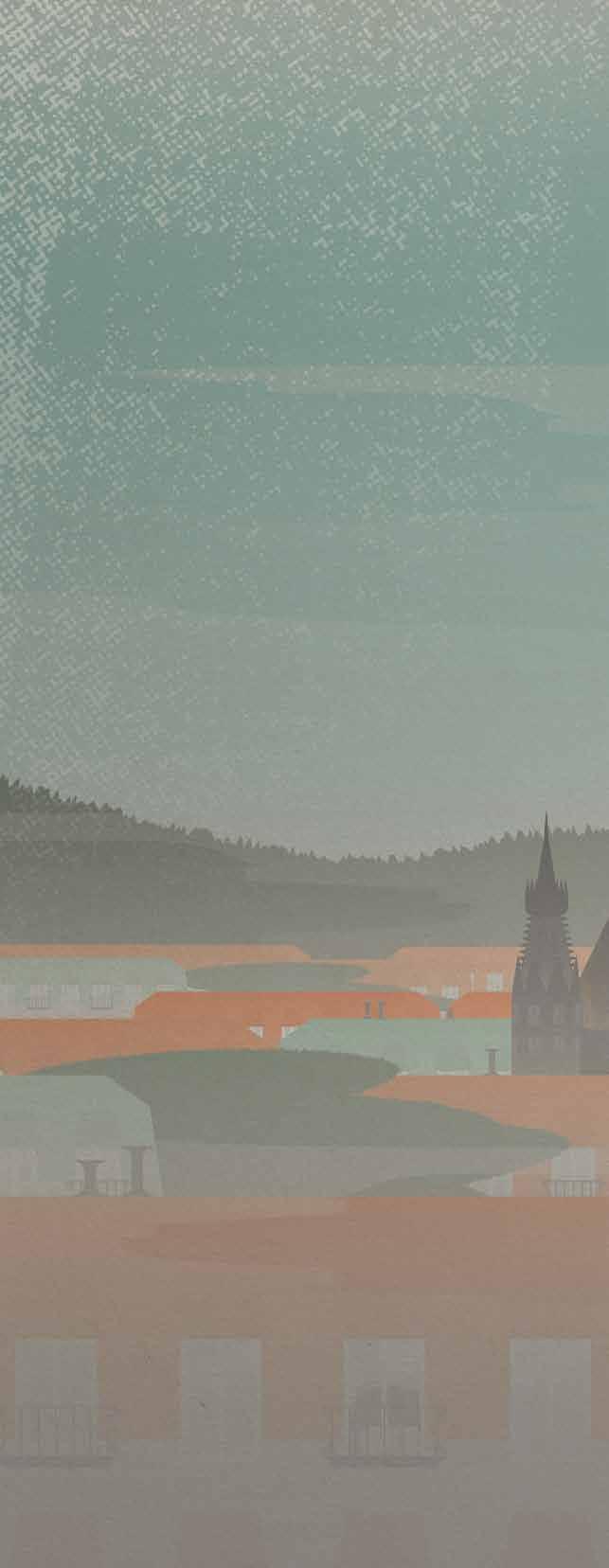
24 ∙
Masterworks 1: McGill & Mozart
Anthony McGill, Clarinet

Clarinetist Anthony McGill is one of classical music’s most recognizable and brilliantly multifaceted figures. He serves as the principal clarinet of the New York Philharmonic, that orchestra’s first AfricanAmerican principal player. Hailed for his “trademark brilliance, penetrating sound and rich character” (The New York Times), as well as for his “exquisite combination of technical refinement and expressive radiance” (The Baltimore Sun), McGill also serves as an ardent advocate for helping music education reach underserved communities. McGill was honored to take part in the inauguration of President Obama, premiering a piece by John Williams alongside violinist Itzhak Perlman, cellist Yo-Yo Ma, and pianist Gabriela Montero.
McGill appears regularly as a soloist with top orchestras around North America including the New York Philharmonic, Metropolitan Opera, Baltimore Symphony, San Diego Symphony, and Kansas City Symphony. As a chamber musician, McGill is a favorite collaborator of the Brentano, Daedalus, Guarneri, JACK, Miró, Pacifica, Shanghai, Takacs, and Tokyo Quartets, as well as Emanuel Ax, Inon Barnatan, Gloria Chien, Yefim Bronfman, Gil Shaham, Midori, Mitsuko Uchida, and Lang Lang. He has led tours with Musicians from Marlboro and regularly performs for the Chamber Music Society of Lincoln Center and the Philadelphia Chamber Music Society. Festival appearances include Tanglewood, Marlboro, Mainly Mozart, Music@Menlo, and the Santa Fe, Seattle, and Skaneateles Chamber Music Festivals.
A graduate of the Curtis Institute, McGill previously served as the principal clarinet of the Metropolitan Opera. He serves on the faculty of the Juilliard School, the Curtis Institute of Music, Bard College’s Conservatory of Music, and the Manhattan School of Music.


Asheville Symphony ∙ www.AshevilleSymphony.org ∙ 25
GUEST ARTIST

26 ∙ www.AshevilleSymphony.org ∙ Fall 2022 Program Book 1848 BREVARD ROAD • ARDEN, NC 28704 • ( 828 ) 252-7667 BUYADVANTAGEPRINTING.COM Digital & Offset Printing Direct Mail Marketing • Variable Data Wide Format Signs, Banners, & Displays Fulfillment Services PRINT & MARKETING COMMUNICATIONS Graphic Design bringing asian comfort food to Asheville since 2014. Proud sponsor of the Symphony. Menu and info at:

Asheville Symphony ∙ www.AshevilleSymphony.org ∙ 27 Hold nothing back. The Audi Q5. Luxury comes standard. Obessively engineered in every way, the Audi Q5 has it all: quattro® all-wheel drive, MMI® touch response system*, sliding and reclining second row seats, and adjustable cargo floor. It’s a high tech, highly versatile SUV that surpasses all expectations, putting the in your rear view for good. Audi Asheville Proud Sponsor of the Asheville Symphony Orchestra 621 Brevard Road, Asheville, NC 28806 828-232-4000 ︱ AudiAsheville.com *Always pay careful attention to the road, and do not drive while distracted. See Owner’s Manual for further details, and important limitations. “Audi,” “quattro,”, “MMI,” all model names, and the four rings logo are registered trademarks of AUDI AG. ©2022 Audi of America, Inc.

28 ∙ ALT ASO @ Highland Brewing
ALT ASO @ HIGHLAND
BREWING
Darko Butorac, Conductor
Nicole Zuraitis, Vocalist
For this ALT ASO concert, we go back to where the series began: Highland Brewing’s gorgeous Event Center. Featuring Grammy-nominated jazz vocalist Nicole Zuraitis as soloist, this program will highlight the music of the 70s — but not just the 1970s! Prepare for a musical tour-de-force featuring music from the 1670s, 1770s, 1870s and 1970s — experience the music of Mozart, Beethoven and Tchaikovsky alongside the Eagles, Stevie Wonder, Carol King, Gloria Gaynor and Queen!

TUESDAY, OCTOBER 4, 2022



7:00 P.M.
AMBER SPONSORS

Henry A. LaBrun
Kevin Pasarilla & Jennifer Marlowe
BOHEMIAN SPONSORS GOLDEN SPONSORS



Michael & Catty Andry
Craig Allen & Julie Cowden
Lynne & John Eramo
Phyllis Penley Patton
Asheville Symphony ∙ www.AshevilleSymphony.org ∙ 29
OFFICIAL AUTOMOTIVE COMPANY OF THE ASHEVILLE SYMPHONY
SERIES PRESENTING SPONSOR
MASTERWORKS 2
Thomas Wolfe Auditorium
Saturday, October 22, 2022, 8:00 p.m.

From Rimsky-Korsakov comes the lavish Scheherazade, a vibrant musical illustration of sandy dunes stretching across the horizon. Explore the vast, wandering Silk Road and central Asia with Say and Borodin. From De Falla, visit a moonlit oasis with his iconic work for piano and orchestra: Nights in the Gardens of Spain.

Darko Butorac, Conductor Adam Golka, Piano
PREMIUM
SPONSORS
OFFICIAL HOTEL OF THE ASHEVILLE SYMPHONY

∙ Masterworks 2: Scheherazade

30
SEASON
OFFICIAL AUTOMOTIVE COMPANY OF THE ASHEVILLE SYMPHONY
In the Steppes of Central Asia
Alexander Borodin (1833-1887)
The illegitimate son of Prince Luka Ghedianov, partly of Armenian descent, Alexander Borodin was registered in accordance with common practices as the lawful son of one of the Prince’s serfs, Porfiry Borodin. Because of the Prince’s attachment to Alexander’s mother, he saw to it that the child received an education that no mere serf could ever expect. And when his father died, he arranged for his son’s freedom by making a suitable match for his mother. Trained as a chemist and a musician, Alexander spent a lifetime juggling his two passions. He made his living as professor of chemistry at the Medico-Surgical Academy in St. Petersburg and also as the first professor of physiological chemistry in the newly founded medical courses for women. Borodin was fluent enough in German, French, English and Italian to translate scientific books. He played the flute, cello and piano and when any time was left over, he composed, calling himself a “Sunday composer.”
Russia’s musical nationalism fitted well with the nineteenth century expansion of the Russian Empire into Central Asia and the dream of Russifying the “primitive” tribes of the area. The composers expressed their fascination by incorporating what they perceived to be the music of the native tribes into their own music. They developed a synthetic “musical orientalism,” the most famous version of which found its way into Rimsky-Korsakov’s Scheherazade. Borodin incorporated it as well, especially in his unfinished opera Prince Igor.
In 1880, to celebrate the 25th anniversary of Czar Alexander II’s ascension to the Russian throne, the planned festivities included a production of historical tableaux, with original music by some of Russia’s most prominent composers. The project came to naught, with only Borodin’s contribution, In the Steppes of Central Asia remaining as a souvenir of the occasion.
The score is a tribute to the tsarist expansionist policy. It contains Borodin’s own detailed description of what is, by his own description, a “musical picture:”
“In the silence of the monotonous deserts of Central Asia are heard for the first time the strains of a peaceful Russian song. From the distance we hear the approach of horses and camels and the melancholy strains of an oriental melody. A caravan emerges out of the measureless steppe, escorted by Russian soldiers, and continues safely and fearlessly on its long way, protected by the formidable military strength of the conquerors. It slowly disappears, as the tranquil songs of the Russians and those of the Asiatic natives merge in harmony, echoes of which linger on as the caravan disappears in the distance.” This vision of Czar Alexander’s empire was decidedly more ideal than it was real.
Noches en los Jardins de España (Nights in the Gardens of Spain)
Manuel de Falla (1876 -1946)
While composers of all periods of Western music have at times made use of popular or folk tunes in their music, the Spaniards seemed obsessed with the practice. The Italian import keyboard composer, Domenico Scarlatti (1685-1750), set the fashion for incorporating “street music” into his sonatas for the brilliant harpsichordist, Queen Maria Barbara. The practice continues to this day.
Born in Cadiz, Manuel de Falla received his first music lessons from his mother. He studied piano and composition in Madrid, where he became interested in Spanish music, especially Andalusian flamenco. But he realized early on that he was not good enough to make a career as pianist, and the symphonic institutions in Spain were too limited to make a living as a classical composer. In 1907, he left Spain in order to achieve international exposure for his music, settling in Paris where he came under the influence of Paul Dukas, Claude Debussy and Maurice Ravel. His music, however, even during the height of the French influence, remained solidly
(continued on next page)
Alexander Borodin
In the Steppes of Central Asia
Music Sponsors
Sam & Robin Harben
Marla Woeckener
Robin & Gordon Gaiser
Manuel de Falla
Noches en los Jardins de España (Nights in the Gardens of Spain)
Adam Golka, Piano
Fazil Say
Music Sponsors
Carol & Hugh McCollum
Donald Gavin & Jayne Schnaars
Piano Concerto No. 2, “Silk Road”
I. White Dove / Black Clouds
II. Hindu Dances
III. Massacre
IV. Earth Ballad
Music Sponsors
Debbie Green
Michael & Catty Andry
INTERMISSION
Nikolai Rimsky-Korsakov
Scheherazade, Op.35

I. The Sea and Sinbad’s Ship
II. The Kalandar Prince
III. The Young Prince and The Young Princess
IV. Festival at Baghdad. The Sea. The Ship Breaks against a Cliff Surmounted by a Bronze Horseman
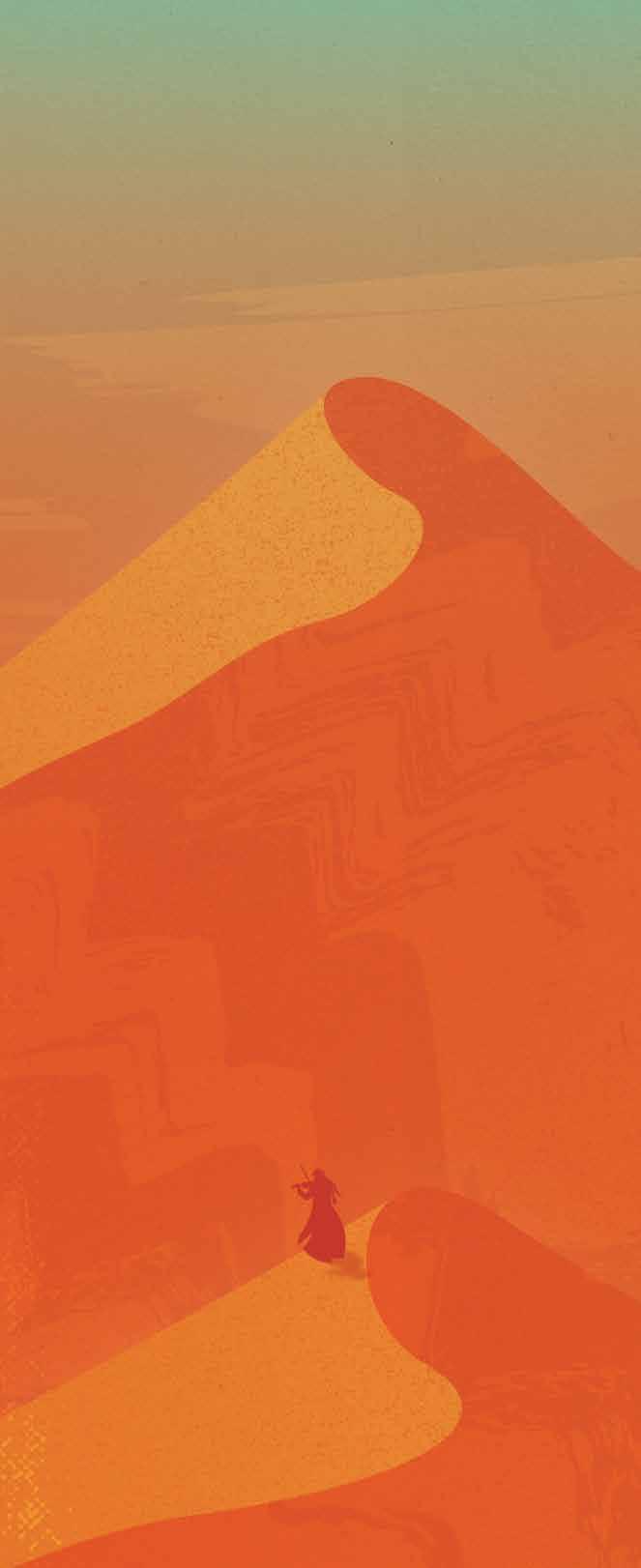
Music Sponsors
Hank Young
CONCERT SPONSOR
GUEST ARTIST SPONSOR
SEASON MEDIA SPONSOR
SEASON RADIO SPONSOR


This performance will be recorded for broadcast on Blue Ridge Public Radio on Nov. 15, 2022 at 7:00pm and Nov. 17, 2022 at 9:00am

PROGRAM NOTES
This project was supported by the North Carolina Arts Council, a division of the Department of Natural and Cultural Resources.
Spanish in style. With the outbreak of World War I, he returned to his native country.
De Falla began Noches en los Jardins de España in 1909 in Paris as a set of three nocturnes for piano. But friends, and especially the pianist Ricardo Viñes, advised him to transform it into a work for piano and orchestra. Instead, the composer put the work aside and did not return to it until 1915, after his return to Spain. He described the work as “Symphonic impressions,” insisting that it was not a piano concerto, and that the piano was an integral part of the orchestral fabric.
Nights is a purely atmospheric work, at times almost hypnotic in its simple melodies and understated orchestration. The first movement En el Generalife, describes the famous Palace garden of the Generalife (from the Arabic Jannat al-’Arif - Architect’s Garden) on the Alhambra hill in Granada. It opens with what sounds like an accompaniment, but is actually the main theme that recalls Debussy. The theme has a Moorish flavor, first heard as if played on a guitar; the strings imitate the strumming sound, while the piano part is often a single line avoiding chords.
In the second movement, Danza lejana (Distant Dance), once again the themes are brief and simple, the rhythm and harmonies evoking the Flamenco style. The dance gradually increases in volume and tempo before receding again into the distance. The piano leads without interruption into the third movement, En los jardines de la Sierra de Córdoba (The gardens of the Sierra Cordoba mountains). In the middle, the piano takes the role of the singer of cante jondo, a vocal Flamenco style in which a florid melody in the high treble sings over a throbbing bass. The movement begins energetically but slows to a brooding conclusion.
Piano Concerto No. 2, “Silk Road”
Fazil Say (b. 1970)
Turkish pianist and composer Fazil Say wrote his first composition, a piano sonata, at age 14, while a student at the conservatory in Ankara. He is a freelance composer and pianist, who considers himself a citizen of the world. He got
into legal trouble in Turkey, being accused of blasphemy, for stating that he was an atheist and poking fun at the Islamist concept of paradise. As a result of the increasing religious intolerance in his country, he has left Turkey.
Influenced by Say’s studies of ancient Eastern folk music in the archives of the Berlin Museum of Ethnology, the Piano Concerto, composed in 1994, follows the route of the old Silk Road from Tibet to Turkey. The first movement, White Dove / Black Clouds, visits Tibet, with emphasis on the sound of the big temple bells gongs. In the second, Hindu Dances, you can hear an imitation of the sitar and the tabla accompanying a dance.
The title of the third movement, Massacre, which describes Mesopotamia, requires little explanation, having been written after the first gulf war. The fourth, Earth Ballad, uses a popular folk-song from Anatolia, the modern Turkey.

In an interview in 2011, Say stated that were he to compose the work again, he would have done so completely differently, this time incorporating traditional Asian instruments into the fabric of the music.
Scheherazade, Op.35
Nikolai Rimsky-Korsakov (1844-1908)
In the tradition of Russian national music, Nikolai Rimsky-Korsakov holds a place of honor. Musically self-taught, he originally trained as a naval officer, serving in that capacity from 1862 to 1873. Throughout his naval career he studied music on the side until 1871 when he won a faculty position at the St. Petersburg Conservatory in spite of the fact that he had little formal training. Until his death he taught and encouraged nearly every young Russian composer from Alexander Glazunov and Anton Arensky to Igor Stravinsky and Sergei Prokofiev.
Rimsky-Korsakov’s inspiration derived from the operas of Mikhail Glinka, whose music combined Russian melodies with the oriental modes of Russia’s vast Eastern provinces. Together with César Cui, Alexander Borodin, Mily Balakirev and Modest Mussorgsky, he formed the group called “The Mighty Five,” whose aim was to promote Russian national music. Ironically, Rimsky-Korsakov was by far the best-trained musician
among them. His use of instrumental color and masterly orchestration was so famous that any Russian composer with serious aspirations made the pilgrimage to his orchestration and composition classes, even occasional foreigners, like Ottorino Respighi who came from Italy. After the deaths of Borodin and Musorgsky, Rimsky-Korsakov edited and completed their manuscripts –especially their operas – and had them published. Unfortunately, he had a habit of “correcting” everything that he considered over the top, from harmonic progressions to the order of scenes, often making the work hardly recognizable.
Rimsky-Korsakov composed Scheherazade, based on A Thousand Nights and One Nights (commonly called the Arabian Nights) in 1888, and it premiered in November of that year. It is among the most colorful works in the orchestral repertoire, glowing with brilliant orchestration and lush solos. The frame story of A Thousand Nights and One Nights tells of a Khalif who was in the habit of killing his wives after a single night of lovemaking. His latest bride, Scheherazade, avoids that fate by telling him suspenseful stories, concluding each evening with a cliffhanger. After years of such nightly entertainment, the Khalif finally decides to keep her.
The Suite comprises four tableaux, in which the yarn-spinning Scheherazade “speaks” through virtuoso passages for solo violin. Her theme ties the tableaux together and is occasionally incorporated into a story. None of the four tableaux, however, is a musical setting for any of Scheherazade’s tales; rather, they allude to the character types and incidents that make up the vast body of stories. The tone poem begins with the low brasses blasting out the theme representing the Khalif, followed by a passage that Rimsky snitched – although he modified it harmonically – from Mendelssohn’s Overture to A Midsummer Night’s Dream, denoting the world of fairytales.
The first tableau, “The Sea and Sinbad’s Ship,” includes a combination of rhythms and changing dynamics that imitate the motion of the waves by means of two principal themes: one is a transformation of the Khalif’s theme while Scheherazade’s theme is transformed to fit the rocking of the waves.
32 ∙ Masterworks 2:
Scheherazade
“The Tale of the Kalendar Prince” changes the pace to reflect a number of loosely bound battle episodes, including a main theme introduced in an English horn solo, and virtuosic fanfare passages for solo trumpet.
The third tableau, “The Young Prince and the Young Princess,” is the most romantic. The violins introduce the first intimate theme, followed by an Oriental dance.
The final tableau is a passionate conversation between the Khalif and Scheherazade, as she readies herself for her last chance at survival. The tableau actually recalls a number of episodes from her repertory of stories; marked in the score are: “The Festival at Baghdad;” “The Sea” (reprise of the theme from the first tableau); “The ship founders on a rock topped by the bronze statue of a warrior;” and “Conclusion.” The music is fiery and exciting until the end, when Scheherazade’s stories come to a quiet and plaintive end as she awaits the fatal verdict of the Khalif, whose theme finally moderates to a gentle section solo for the cellos.
Program notes by: Joseph & Elizabeth Kahn

www.wordprosmusic.com
GUEST ARTIST
Adam Golka, Piano
Polish-American pianist Adam Golka (born 1987) first performed all of Beethoven’s Piano Sonatas when he was 18 years-old, and in 2020-2021 Adam Golka performed the cycle of Beethoven’s 32 Sonatas at the Bach Festival Society of Winter Park (Florida) and at Saint Thomas Church Fifth Avenue (NYC), in sociallydistanced and live-stream formats. Adam’s performances of each Sonata were complemented by 32 short films he created, known as 32@32 (available on YouTube), documenting his preparation for climbing the Everest of piano literature and featuring an amalgam of distinguished guests, from an astrophysicist to Alfred Brendel.

Adam Golka’s principal teachers have been José Feghali, with whom he studied at Texas Christian University, and Leon Fleisher, at the Peabody Conservatory. Since finishing his formal studies, Adam has continued to develop his artistry through many mentors including Alfred Brendel, Richard Goode, Murray Perahia, and Sir András Schiff, who invited Adam to give recitals at the Klavier-Festival Ruhr and Tonhalle Zürich, for the “Sir András Schiff Selects” concert series. Adam has also given solo recitals in Tokyo’s Musashino Hall, New York’s Alice Tully Hall (presented by the Musicians Emergency Fund), and Amsterdam’s Kleine Zaal in Het Concertgebouw.
As a concerto soloist, he has appeared with dozens of orchestras, including the BBC Scottish Symphony, NACO (Ottawa), Warsaw Philharmonic, NFM Leopoldinum, Shanghai Philharmonic, as well as the San Francisco, Atlanta, Houston, Dallas, Milwaukee, Indianapolis, New Jersey, and San Diego symphonies in the US, among many others. Adam gave his Carnegie Stern Auditorium début in 2010 with the New York Youth Symphony.
Chamber music is an integral part of Adam Golka’s life, and he has performed repeatedly at the Krzyżowa-Music “Music for Europe” festival, which has included tour performances at the Mecklenburg-Vorpommern and the Beethoven Bonn festivals, as well as Konzerthaus Berlin. He also performed at the Marlboro, Ravinia, Caramoor chamber music festivals in the US.
Adam’s professional life began when he was awarded the first prize and audience prize at the 2nd China Shanghai International Piano Competition. In 2009, he won the Max I. Allen Fellowship from American Pianists Association. As a pedagogue, he acted as Artist-in-Residence for six school years at the College of the Holy Cross in Worcester, Massachusetts. Adam has recorded works by Beethoven, Schumann, and Brahms for Londonbased First Hand Records and he has premiered works composed for him by Richard Danielpour, Michael Brown, and Jarosław Gołębiowski.
Helle Creative is proud to support and collaborate with your Asheville Symphony.
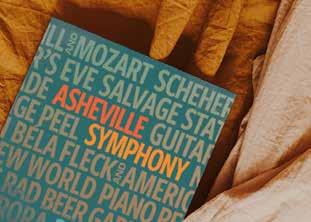
Asheville Symphony ∙ www.AshevilleSymphony.org ∙ 33
WORK
Specializing in branding, print and web design for creative entrepreneurs and businesses.
LET'S
TOGETHER // VISIT HELLECREATIVE.COM
HELLE CREATIVE // WEST ASHEVILLE
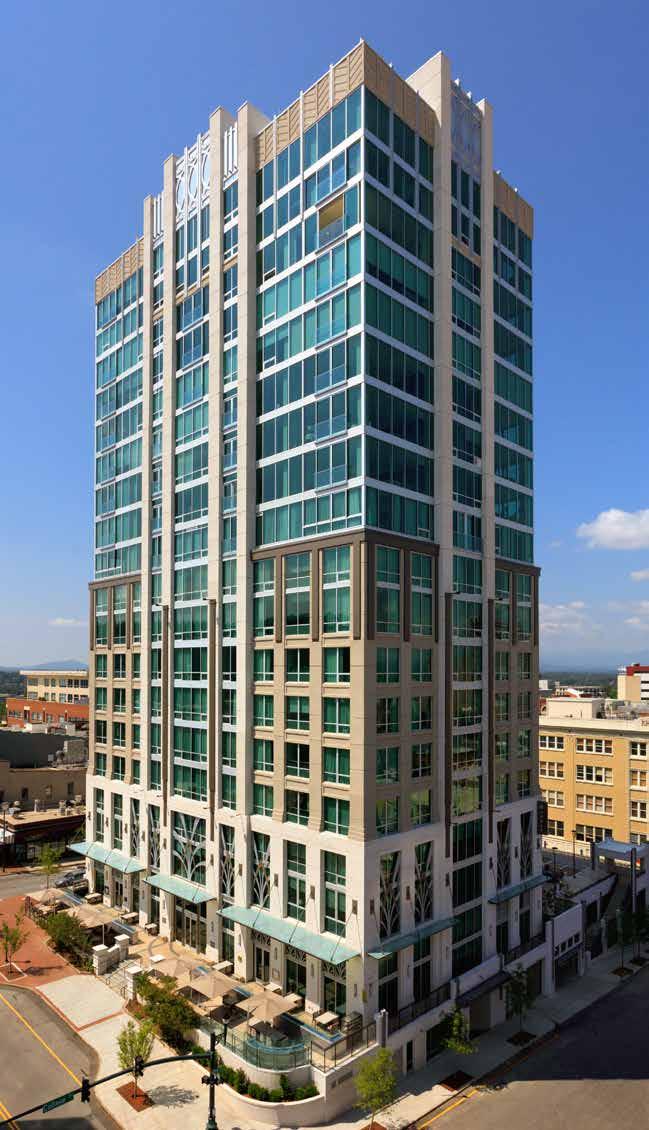

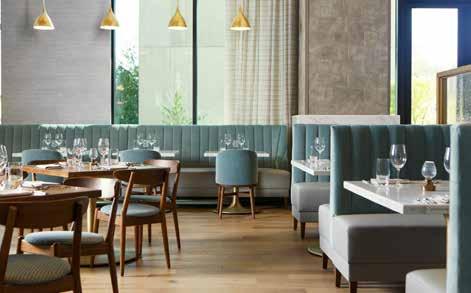


Asheville Symphony ∙ www.AshevilleSymphony.org ∙ 35 7 PATTON AVENUE | ASHEVILLE, NC 28801 | 825.255.0303 | HOTELARRAS.COM We proudly support the Asheville Symphony Orchestra
MASTERWORKS 3
Thomas Wolfe Auditorium
Saturday, November 19, 2022, 8:00 p.m.

“The language of music is understood by everybody,” according to Rossini, “since it is understood with the heart.” We bring that notion to life with this program filled with operatic classics. A curated selection of operatic works (including beloved masterpieces by Italian masters Puccini and Verdi) explore the experiences and emotions that all of humankind shares through the combined power of the stage, voice, and orchestra.
Darko Butorac, Conductor
Ceclilia Violetta López, Soprano
Ben Gulley, Tenor

Jeff Mattsey, Baritone
∙ Masterworks 3: Night at the Opera

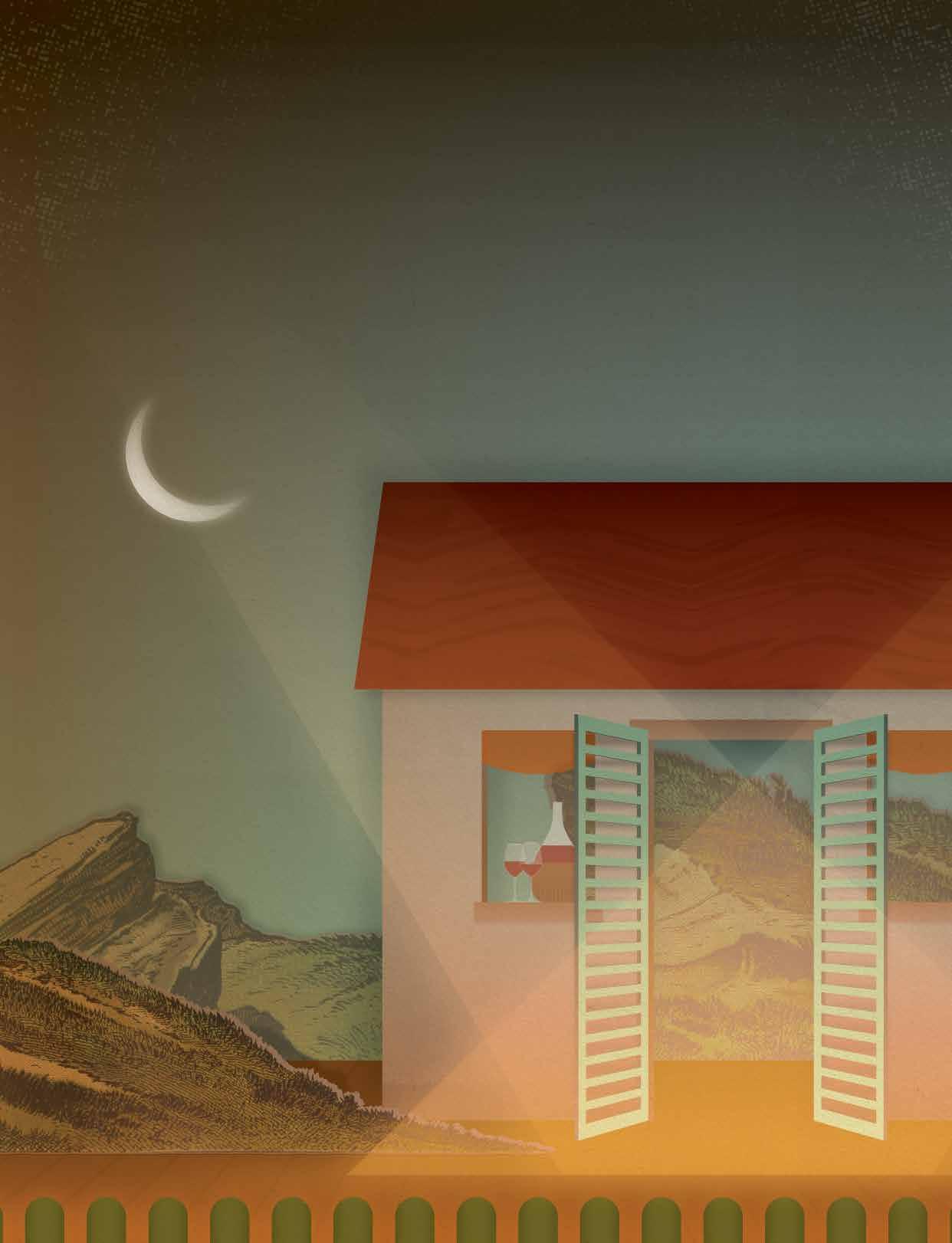
36
OFFICIAL HOTEL OF THE ASHEVILLE SYMPHONY OFFICIAL AUTOMOTIVE
PREMIUM SEASON SPONSORS
COMPANY OF THE ASHEVILLE SYMPHONY
Overture to Guillaume Tell (William Tell)
Gioachino Rossini (1792-1868)
Between 1810 and 1829 Gioachino Rossini wrote an astonishing 38 operas. Then, at age 37, he quit. For the rest of his long life he concentrated on his avocation as a gourmet cook and grew appropriately in bulk. He composed only sporadically and, except for church music, mostly small works he tossed off for the entertainment of his friends. He published over 150 musical miniatures in a collection that he called Péchés de vieillesse (Sins of old age).
Rossini’s final opera, Guillaume Tell, based on a play by Schiller, was written in 1829 for the Academie Royale de Musique with the intent to conquer the Paris opera scene. Rossini had aspired to a ten-year contract to produce operas in Paris, composed specifically for a French audience – as opposed to his previous productions that were merely translations of Italian operas written for Naples. Unfortunately, the revolution of 1830 overthrew France’s King Charles X, and Rossini was forced to cool his heels for six years. Guillaume Tell had already forced him to revamp his style considerably to conform to French taste and new composers were assuming the Parisian limelight while he was stalled. The opera, nearly 4 hours long, premiered in 1829, but Rossini immediately tinkered with it in rehearsal and subsequently shortened it. Since he had acquired considerable wealth from his Italian operas, the effort required to “keep up with the Jonses” may simply have not been worth it.
The Overture – the finale of which became the signature theme for The Lone Ranger, one of radio’s longest running shows – is different from any other Rossini wrote. It is programmatic, suggested by the alpine setting and the finale of the opera (although not using the same music): the alpine sunrise, for five solo celli, the storm, the clearing skies and the shepherd’s song of thanks for English horn – all with a strong, and probably non-coincidental, relationship to Beethoven’s Pastoral Symphony – the trumpet call to arms and the rush of the soldiers. Many later nineteenth century
opera composers adopted this type of overture, notably Verdi in Nabucco and La forza del destino and Wagner in The Flying Dutchman and Die Meistersinger.
“Anvil Chorus” from Il Trovatore, Act III.
Giuseppe Verdi (1813-1901)
Il Trovatore is based on El trobador, a Spanish melodrama by Antonio Garcia Gutierrez (1813-1844). The Count di Luna’s brother is believed to have perished in infancy at the hands of a Gypsy, whose daughter Azucena actually saved him and brought him up as her own son, Manrico. Now an adult, Manrico has distinguished himself as a warrior and troubadour and finds himself the Count’s rival for the love of Leonora, who loves Manrico. By the time it’s all over, Leonora has swallowed poison rather than submit to di Luna, who has executed Manrico, only to find out from Azucena that he has killed his own brother.
In the so-called “Anvil Chorus” from Act III, the Count’s soldiers prepare to besiege the castle where Manrico is harboring Leonora.
“Humming Chorus” from Madama Butterfly, Act II.

Giacomo Puccini (1858-1924)
Madama Butterfly, a grim picture of the lethal clash of cultures between East and West, is based on an actual event. Pinkerton an officer in the US Navy during the 1880s, undertakes a sham wedding with a fifteen-year-old geisha, Cio Cio San – known as Butterfly – who takes the vows seriously. When he returns to the States, promising Butterfly he’ll come back, she waits for him faithfully with their child, whose existence Pinkerton is unaware of. Meanwhile, he has married an American woman and is posted back to Japan. Butterfly, expecting Pinkerton to return to her, is informed of the awful truth. Realizing all is lost, she gives up the baby to the new wife and commits suicide. During World War II, Madama Butterfly was the only opera banned from the stage of the Metropolitan Opera House
(continued on next page)
Gioachino Rossini
Overture to Guillaume Tell (William Tell)
Sponsored by Jessica & David May
Giuseppe Verdi
“Anvil Chorus” from Il Trovatore
Giacomo Puccini
“Humming Chorus” from Madama Butterfly
Giuseppe Verdi
“Povero Rigoletto” from Rigoletto
Giacomo Puccini
Finale of Act I. from La bohème
Giuseppe Verdi
“Va pensiero, sull’ali dorate” (Chorus of the Hebrews) from Nabucco
Sponsored by J. Howard and Honey Solomon
INTERMISSION
Giuseppe Verdi
“Gloria all’Egitto” from Aïda
Pietro Mascagni
Intermezzo from Cavalleria rusticana
Sponsored by Daniel & Caroline Crupi
Giuseppe Verdi
Prelude to Act III. from La traviata
Giuseppe Verdi
Act II., Scene 2 from La traviata
Sponsored by Michael & Catty Andry
CONCERT SPONSOR
David & Pamela Lane
GUEST ARTIST SPONSORS
Bob & Martha Pierce in memory of Dr. Elizabeth Pierce Litteral
Donald Gavin & Jayne Schnaars
SEASON MEDIA SPONSOR
SEASON RADIO SPONSOR


This performance will be recorded for broadcast on Blue Ridge Public Radio on Feb. 14, 2023 at 7:00pm and Feb. 16, 2023 at 9:00am

PROGRAM NOTES
because of its negative portrayal of an American officer and the sympathetic portrayal of a Japanese woman.
The Humming Chorus in the end of Act II, accompanies Butterfly’s night-long silent vigil as she waits for Pinkerton’s return.
“Povero Rigoletto” from Rigoletto, Act II.
Giuseppe Verdi (1813-1901)
Verdi adapted Rigoletto from an already controversial play, Le Roi s’amuse (The King Enjoys Hinself) by the scion of French Romanticism Victor Hugo. The plot centered on Triboulet (a fictional character), the hunchbacked jester of France’s King François I (14941547), whose daughter is seduced and dishonored by the libertine monarch. Hugo’s play was banned in France after its first performance, but the cat was out of the bag. Verdi, who for years had been contemplating an opera on Shakespeare’s King Lear – another play about a severely compromised monarch, and his fool – had also been enthusiastic about Hugo’s play for years. In a letter to his librettist Francesco Piave, he wrote: “Le Roi s’amuse is the greatest subject and perhaps the greatest drama of modern times.” The censors did not agree.
Povero Rigoletto is from Act II. The courtiers taunt Rigoletto as he gradually realizes that his beloved daughter has been seduced by the Duke and he begs for her return.
Finale of Act I. from La bohème
Giacomo Puccini
(1858-1924)
La bohème opens on Christmas Eve in a Paris garret rented by four artists: Rudolfo is a poet, Marcello a painter, Schaunard a musician and Colline a philosopher. With only a few introductory measures, Puccini barges right into the little apartment, where Rudolfo and Marcello are freezing until Rudolfo finally tears up and burns his latest play as a contribution to the crisis. Schaunard and Colline enter with food and wine.
The friends decide to spend the rent money on a Christmas Eve splurge. Rudolfo, however, decides to stay home to work, when he is interrupted by his neighbor, Mimi, whose candle has gone
out on the stairs. She asks Rudolfo to light it for her but as she enters, she is seized by a fit of coughing that alarms him. She then realizes that she has dropped her key and the two of them crawl around in the dark looking for it, although Rudolfo has immediately spotted it and pocketed it. He manages to surreptitiously touch her hand. The chemistry works. They tell each other a little about themselves, fall in love and go out to meet the rest of the gang and celebrate.
“Va pensiero, sull’ali dorate” (Chorus of the Hebrews from Nabucco, Act III.
Giuseppe Verdi (1813-1901)
Verdi composed his first success, Nabucco, as he mourned the untimely death of his first wife and two young children, pouring his sense of longing and abandonment into the chorus of the exiled Israelites, “Va, pensiero, sull’ali dorate.” (Fly, thought, on golden wings)
The opera enacts the story of the destruction of the Temple in Jerusalem in 586 C.E. by King Nebuchadnezzar (Nabucco) from the Book of Daniel –with significant non-biblical accretions –the King’s Divine punishment of madness and his repentance. The chorus, from Act III, is the homesick lament of the enslaved Hebrews hoping for a return to their homeland. This chorus not only became an instant sensation, but also became the “theme song” for the Risorgimento (the uprising for the unification of Italy).
by the French Egyptologist, Auguste Mariette. Upon the request of Ismail Pasha, the Khedive of Egypt, Mariette had entrusted du Locle to engage Verdi – and if he couldn’t get Verdi, then either Gounod or Wagner – to compose the work for the new Cairo Opera House. Aïda was finally premiered in Cairo on December 24, 1871.
Aïda involves a classic love triangle. Radames, leader of the Egyptian army, loves Aïda, a captured Ethiopian princess, now a slave of the Egyptian princess Amneris, who also loves Radames.

At the triumphal procession celebrating another victory over the Ethiopians, as the chorus sings “Gloria all’Egitto,” Aïda discovers her father Amonasro in disguise among the captives.
Subsequently, Amonasro urges Aïda to seduce Radames into deserting to the Ethiopians, but Amneris overhears the conspirators. At his trial before the priests of Isis, Radames refuses to defend himself and is condemned to be buried alive. While Amneris prays over his tomb, Radames discovers Aïda hidden in a corner, and the lovers consume the remaining oxygen in a final farewell duet.
Intermezzo from Cavalleria rusticana
Pietro Mascagni (1863-1945)
“Gloria
all’Egitto” from Aïda, Act II.
Giuseppe Verdi (1813-1901)
By the time Verdi undertook the composition of Aïda, he was world famous, wealthy and able to dictate the terms of every aspect of a new opera. Between 1867 and 1870 Camille du Locle, the new director of the Opéra Comique in Paris, bombarded Verdi with proposals for a new opera. Verdi, who had his heart set on a comedy, rejected some out of hand and mused over the possibility of others until in 1870 du Locle forwarded to him a four-page scenario set in ancient Egypt.
Although there is still some debate over the ultimate source of the story, du Locle’s proposal was a translation of a scenario
“It was a pity I wrote Cavalleria first. I was crowned before I was king.” Thus did Pietro Mascagni evaluate his own musical career, citing his youthful success in 1890. The only one of his 15 subsequent operas, occasionally staged today, is L’amico Fritz, a gentle comedy, the absolute opposite of Cavalleria. Sadly, in his later years, Mascagni became a mouthpiece for Italy’s Fascist government. In 1929 he took over as conductor at La Scala in Milan when Arturo Toscanini resigned in protest over the Fascist regime.
Responding to an advertisement for a one-act opera competition promoted by a publisher, Mascagni composed his masterpiece in only a few weeks but did not consider it suitable, choosing to send in an act from an earlier opera instead. His wife, however, submitted the score of Cavalleria without his knowledge, and the rest is history. Cavalleria is an adaptation of the novella by the Sicilian writer Giovanni Verga the originator and most important representative of the verismo literary movement. Verismo,
38 ∙ Masterworks 3: Night at the Opera
or “realism,” portrayed the brutality of the social environment and characters of rural Sicily and Southern Italy.
The single act includes an adulterous love triangle, jealousy, betrayal and a duel to the death. The Intermezzo precedes the final scene, as the villagers emerge from the Easter Sunday service, just before the fatal duel.
Prelude to Act III. and Act II., Scene 2 from La traviata Giuseppe Verdi (1813-1901)
In La Traviata Verdi completely broke with tradition. Based on La dame aux camélias by Alexandre Dumas, a French bestseller of the previous year that was immediately dramatized, La Traviata was the first tragic opera to treat a contemporary subject. Even more scandalizing was the fact that the heroine was a courtesan; and although Violetta Valéry travels only in the best Parisian circles, the word “traviata” literally means “fallen” or “debauched.” Verdi had also intended that the opera be staged in contemporary dress, an innovation that so disturbed his producer that the composer had to abandon that battle in order to win the war.
The mournful prelude to Act III sets the mood for the final act. Violetta has renounced her lover, Alfredo, for the sake of his family’s honor and his sister’s wedding. Unaware of her sacrifice, Alfredo has denounced her in public as a common prostitute. Violetta, whose health was always precarious, is now dying of consumption and a broken heart.
Act 2, scene 2 takes place at Flora’s ball, where there are also gaming tables, some of the guests dress as gypsies and matadors to perform a ballet for the rest of the company. Alfredo enters and asks Flora about Violetta, when Violetta appears on the baron’s arm, obviously distracted. Alfredo challenges Douphol to a card game, while Violetta laments her increasingly desperate situation. Alfredo returns from the gaming table, where he has wiped out Douphol, and throws his winnings at Violetta. In an emotional ensemble, Violetta pleads with Alfredo, the guests express their dismay at Alfredo’s behavior, and Germont appears to shepherd his son out of the melée.
Program notes by: Joseph & Elizabeth Kahn

www.wordprosmusic.com
Celebrated soprano, Cecilia Violetta López, has been named one of “Idaho’s Top 10 Most Influential Women of the Century” by USA Today and has been named one of opera’s “25 Rising Stars” by Opera News. The singing actress is constantly praised for her “alluring voice and incredible range” (Washington Post).

She has received accolades for her signature role of Violetta in La traviata, which she has performed countless times throughout North America. Critic, James Jorden, exclaimed “she is a Violetta fully-formed and, I think, ready for the great stages of the world.” She has now performed the role with Minnesota Opera, Opera Colorado, Opera Tampa, Opera Idaho, Ash Lawn Opera, The Northern Lights Music Festival, and more. Ms. López made her European début as Norina in Don Pasquale with Zomeropera in Belgium, for which Klassiek Centraal exclaimed: “She turns out to be the revelation of the show and wins over the audience with her funny rendition, irresistible charm, and [she is] natural in the different vocals.”
The American operatic tenor, Ben Gulley, is hailed as “an outstanding tenor (Opera News) ... startlingly-gifted (San Francisco Classical Voice).” Mr. Gulley’s career is burgeoning with lead and feature roles in opera, solo engagements, concert work, film work, nationwide touring, and prestigious appearances abroad. Mr. Gulley is the 2009 winner of the Metropolitan Opera’s National Council District & Regional Competitions and a National Semi-Finalist. Other awards include the winner of the Hellam Young Artists’ Competition, Richard Tucker Foundation finalist, Florida Grand Opera competition finalist, Silver Medalist and People’s Choice Award from the Tulsa Rotary Club’s Competition, and more. His career has seen him perform across the globe within an array of musical forms and genres. From the stages of Carnegie Hall to The Corn Palace, from centerstage to behind the camera, Mr. Gulley is grateful to dedicate his life to expressing great music and telling stories for audiences everywhere.
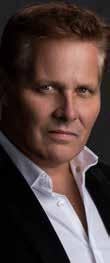
American Baritone Jeff Mattsey is known worldwide for the roles that have defined his international career. He made his operatic stage debut at the age of 21 as Marcello opposite Luciano Pavarotti in the Opera Company of Philadelphia production of La Boheme. Since that time he has made appearances with such companies as the Metropolitan Opera, the San Diego Opera, Boston Lyric Opera, Vancouver Opera, Opera di Genova, Deutsche Oper Berlin, New York City Opera, Houston Grand Opera, and many more. A versatile actor, Mr Mattsey is at ease in both comic and dramatic works, from Figaro in the Barber and Marriage of Figaro to Sharpless in Butterfly or Papa Germont in La Traviata Of a recent performance, the San Diego Tribune says: “Baritone Jeff Mattsey was an extraordinary Marcello: extraordinary because he created a character so rich and textured with so little apparent effort – and sang the role with such an outpouring of warm, burnished sound…”

GUEST ARTISTS
Cecelia Violetta López, Soprano
Ben Gulley, Tenor
Jeff Mattsey, Baritone
Interim Chorus Conductor KYLE RITTER

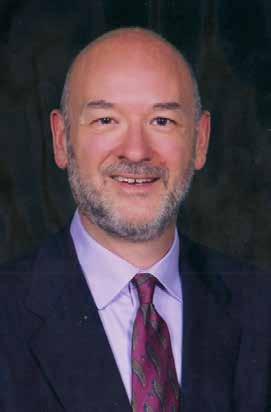
Kyle Ritter is Canon for Music at The Cathedral of All Souls in Asheville, North Carolina. At All Souls, he oversees a comprehensive choral program involving children and adults. The Cathedral Choir has toured regionally to both St. Philip’s Cathedral in Atlanta and St. Peter’s Episcopal Church in Charlotte, and the St. Cecilia Youth Choir has toured to Atlanta, where they sang at Holy Innocents’ Church, and Charlotte at Christ Episcopal Church. Prior to his appointment at All Souls, Mr. Ritter was Minister of Music at St. Mary’s Episcopal Church in Arlington, Virginia, a position he held from 1993-2002. He earned both bachelor’s and master’s degrees in organ and church music from Indiana University, where he was a student of Robert Rayfield and Marilyn Keiser. Kyle grew up in Evansville, Indiana, where he began piano lessons at age five with Jan Thornton-Irvine. He started organ lessons with Julian Irvine at ten years of age. He has held various positions of leadership in the American Guild
of Organists, including dean of both the Bloomington, Indiana and Western North Carolina Chapters and registrar for the District of Columbia chapter. For four years, he served the Guild as District Convener for the state of North Carolina. Mr. Ritter is Vice-President of the Association of Anglican Musicians, and has served also as a past regional officer, Placement Advisor, and on the editorial board for the AAM Journal. He was Adjunct Instructor in Liturgics at Virginia Theological Seminary in Alexandria, and taught in the Episcopal Dioceses of Washington and Virginia for the Leadership Program for Musicians (LPM). Mr. Ritter was for several years on the adjunct music faculty at Brevard College and as chair of the Liturgy and Music Commission of the Diocese of Western North Carolina. For five years, he served as Assistant Director/Accompanist for the Asheville Symphony Chorus. He is a member of Pi Kappa Lambda honorary music society.
40 ∙ www.AshevilleSymphony.org ∙ Fall 2022 Program Book
*Home
prior
at any time without notice or obligation.
and sizes are approximate for illustration purposes only and will vary from the homes as built DRHORTON.COM HENDERSONVILLE
CANDLER WEAVERVILLE . . . . from the high 300s – the high 400s $ * 9 ACTIVE COMMUNITIES $ Offering Townhomes & Single Family Homes
and community information, including pricing, included features, terms, availability and amenities are subject to change and
sale
Pictures, photographs, drawings, features, colors, square footage
ARDEN ASHEVILLE


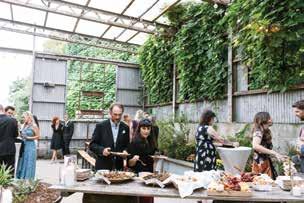



Asheville Symphony ∙ www.AshevilleSymphony.org ∙ 41
Saturday, December 31, 2022, 8:00 p.m.



Thomas Wolfe Auditorium
It’s Bond, James Bond, and your Asheville Symphony! Ring in the New Year with powerhouse vocalists backed by your Symphony and dreams of martinis (shaken, not stirred), Aston Martins, custom watches from Q, and the beloved MI6 agent. With hits from Bond movie favorites like Goldfinger, Skyfall, and more, start the new year in style by unleashing your inner Bond (or Bond girl).
Darko Butorac, Conductor Mikki Sodergren, Soprano Jonathan Christopher, Baritone

42 ∙ New Year’s Eve with 007
OFFICIAL HOTEL OF THE ASHEVILLE SYMPHONY PREMIUM SEASON SPONSORS OFFICIAL AUTOMOTIVE COMPANY OF THE ASHEVILLE SYMPHONY
James Bond Theme from Dr. No
Monty Norman, Terence Young
Sponsored by James S. Thompson
From Russia With Love
Marty Norman
Mikki Sodergren
Singing “beautifully and intelligently” (Jay Nordlinger, The New Criterion), Mikki Sodergren’s stylistic flexibility has afforded her an enriching and musically diverse career. Ms. Sodergren has developed new musicals for NYU Tisch, the BMI LehmenEngel Songwriting program, Disney Theatricals and the National Theatre of Great Britain, and has toured internationally with several ensembles, including the award-winning English Concert, the Grammy®-nominated Clarion Choir, and early music ensemble Meridionalis.
Ms. Sodergren often performs with symphonic orchestras on both classical engagements and pops programs. Ensembles include the Asheville, Jacksonville, Tallahassee, Charleston, Hilton Head, and Johnstown Symphonies, the Savannah Philharmonic, the Washington Bach Consort, and others. Performing as the Mezzo-soprano soloist for Beethoven’s Ninth Symphony, Vivaldi’s Gloria, Handel’s Messiah, Haydn’s Harmoniemesse and many pops programs, Mikki thrives on stylistic integrity and varied musical programming. Recording extensively, Ms. Sodergren’s work has received three Grammy® nominations, including a 2021 Grammy® award for performing on the recording of Dame Ethel Smyth’s The Prison. Sodergren will be featured as the Alto Soloist on the forthcoming recording by the Clarion Choir of Rachmaninoff’s Vespers
Recent performances include performing with the award-winning Metropolitan Opera Chorus and Orchestra under the direction of Met Music Director Yannick Nezet-Seguin for performances of Mahler’s

Resurrection Symphony, and Verdi’s Requiem, aired live on PBS and the World Trade Center Memorial, in memory of the 20th Anniversary of 9/11, and in celebration of the historic return of the Met after 18 months of closure. She has also been seen in the highly-lauded world premiere of Kamala Sankaram’s Looking At You, and can be heard on the original cast album, a Billboard chart topper for Classical charts in 2021. Sodergren made her Carnegie Hall debut in 2019 as the mezzo-soprano soloist in Dan Forrest’s Requiem for the Living, and has performed Aldonza/Dulcinea (Man of La Mancha), opposite TONY and EMMYnominated actor Ron Raines, as well as Eponine (Les Miserables) opposite Broadway legend, Craig Schulman.
Ms. Sodergren currently serves as Executive and Artistic Director of the only international, professional voice organization to dedicate themselves to the preservation, celebration and performance of all styles of classic American song: the American Traditions Vocal Collection. When all styles of American song are celebrated equally, all vocalists have the opportunity to shine.
Mikki resides in Savannah with her beloved cat, Djibouti.
Jonathan Christopher
Praised for his “hearty baritone” voice, Bermudian-Bostonian Jonathan Christopher is swiftly establishing himself as a premier versatile vocalist in New York City and
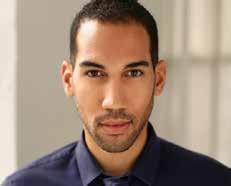
on next page)
Sponsored by Susan Harrington
Butts & Timothy Butts
007 Theme from From Russia With Love
John Barry
Diamonds Are Forever
John Barry, Don Black

Sponsored by Sue & George Luther
On Her Majesty’s Secret Service
John Barry, Hal David
We Have All the Time in the World
John Barry, Hal David
Sponsored by Daniel & Caroline Crupi
Moonraker
John Barry
Goldeneye
Bono, The Edge
Nobody Does It Better
Marvin Hamlisch, Carole Bayer Sager
Sponsored by Michael & Catty Andry
Thunderball
John Barry
Casino Royale
David Arnold
Sponsored by Adarrell Gadsden & Marcie Ownbey
Writing’s On The Wall

Sam Smith, Damian Kulash, Jimmy Napes, Tim Nordwind
Sponsored by Jessica & David May
Nisi Dominus — Cum Dederit
Antonio Vivaldi
Sponsored by Samsel Architects

No Time To Die
Billie Eilish, Finneas O’Connell, arr. Zimmerman
Sponsored by Debbie Green
Soul Bossa Nova from Austin Powers
Quincy Jones
Sponsored by Mary Ellen Dendy & Aaron Dahlstrom
What the World Needs Now from Austin Powers
Hal David, Burt Bacharach
Sponsored by Adarrell Gadsden & Marcie Ownbey
Goldfinger
John Barry, Leslie Bricusse
Sponsored by Darko Butorac

Live and Let Die
Sir Paul McCartney, Hurby Azor, Lind McCartney
Sponsored by James S. Thompson
Skyfall
Thomas Newman
Sponsored by Billie & Larry Marzullo

GUEST ARTISTS
INTERMISSION CONCERT SPONSOR GUEST ARTIST SPONSOR SEASON MEDIA SPONSOR OFFICIAL AUTOMOTIVE COMPANY OF THE ASHEVILLE SYMPHONY SEASON RADIO SPONSOR
(continued
around the world. In New York he has performed in critically acclaimed productions at Lincoln Center (Davóne Tines and Michael Schachter’s The Black Clown), Signature Theatre (Dave Malloy’s Octet), and Brooklyn Playhouse Theatre (David Chesky’s La Farranucci), and has been seen singing in the world renown cabarets of Joe’s Pub, The Duplex, and Don’t Tell Mama. Jonathan has been involved with two musicals set to open on Broadway in the coming seasons and has performed in musicals and operas throughout North America, Europe, and the Caribbean, including the role of Collins in the Aruban premiere of the musical Rent
In concert, Jonathan toured Italy with the gospel quartet Gospel 4; Germany with the opera band The Cast; his native Bermuda; and southeast Asia, Oceania, the Middle East, and the Mediterranean while onboard the luxury liner Seabourn Encore, performing alongside Broadway lyricist Sir Tim Rice.
Over the years Jonathan was seen dancing with Diana Ross, working out with Lady Gaga, and most triumphantly singing with Celine Dion on the Today Show! An

absolute career and personal highlight was hosting Bermuda’s first ever Pride in 2019 alongside his father, Bermudian Town Crier Ed Christopher. Along with his brother, fellow actor Nicholas Christopher, Jonathan received the prestigious 2020 of Bermuda Award. To top it all off, Jonathan is a member of the Hamilton National Tour, understudying Aaron Burr and George Washington and having played the Canadian premiere in Toronto.
With degrees in voice and opera from the University of Michigan and McGill University, Jonathan looks forward to continuing his eclectic and ever-evolving musical journey.
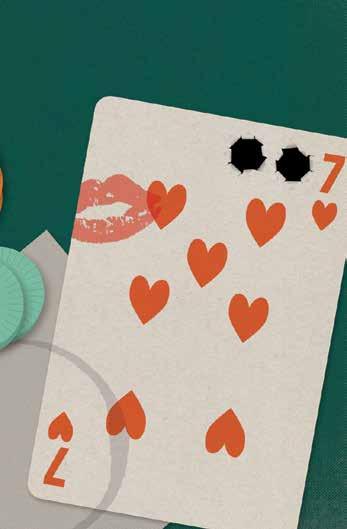


44 ∙ New Year’s Eve with 007
47 Biltmore Avenue Asheville, NC 28801


























































































































































































































Asheville Symphony ∙ www.AshevilleSymphony.org ∙ 45 C ovenant Keeping our promises C ommunity Dedicated to serving C ommitment To the common good FlowAuto.com Audi Porsche Volkswagen
Central United Methodist Church
Tuesday, January 31, 2023, 7:00 p.m.



“The daring creativity and fierce passion Ozel channeled surpasses musicians twice or even three times his age.” American pianist Evren Ozel has won numerous honors and awards including scholarships from the U.S Chopin Foundation and Young Arts Foundation, first prize at the 2016 Boston Symphony Concerto Competition, and second prize as well as Mozart and Chopin special prizes at the 2018 Dublin International Piano Competition. Ozel presents an exquisite program exploring polyphony, the musical concept of multiple independent melodic lines occurring at the same time.

46
∙ Piano Recital with Evren Ozel
Evren Ozel, Piano
OFFICIAL HOTEL OF THE ASHEVILLE SYMPHONY OFFICIAL AUTOMOTIVE COMPANY OF THE ASHEVILLE SYMPHONY
PREMIUM SEASON SPONSORS
Variations on a Theme of Corelli, Op.42
Sergei Rachmaninoff (1873-1943)
After leaving Russia in 1917, economic necessity forced Sergey Rachmaninov to become primarily a pianist, with little time for composing. The Variations on a Theme of Corelli, written in 1931, was the only – and last – solo piano work he composed after that.
The theme, called La folia, is a chord sequence that can be traced back to Portugal and Spain of the late sixteenth century. Originally it was a wild Spanish dance – “folia” means insanity in Spanish. In the course of time and its migration to Italy, it became tamer and found its way into art music. Themes and variation have been around since the Middle Ages, and variations on the “folia” theme became fashionable as early as 1680; there are more than 150 sets of them, but the best-known is Arcangelo Corelli’s Violin Sonata op. 5, No. 12.
Rachmaninov’s work consists of the theme, 20 variations and a coda, with an intermezzo between variations 13 and 14. While technically very challenging, the variations are more subdued than Rachmaninov’s earlier piano works, and he realized their limited public appeal. In a letter to his friend, the composer Nicholai Medtner, he wrote:
“I’ve played the Variations about fifteen times, but of these fifteen performances only one was good. The others were sloppy. I can’t play my own compositions! And it’s so boring! Not once have I played these all in continuity. I was guided by the coughing of the audience. Whenever the coughing would increase, I would skip the next variation. Whenever there was no coughing, I would play them in proper order. In one concert, I don’t remember where - some small town - the coughing was so violent that I played only ten variations (out of 20). My best record was set in New York, where I played 18 variations.”
Scherzo No. 4 in E major, Op.54 Frédéric Chopin (1810-1849)
In the days of the early Baroque, the term “scherzo” (joke) denoted a light-hearted vocal piece or a movement of a larger instrumental composition. Beethoven firmly established the form as a substitute for the traditional minuet and contrasting trio movement of the classical symphony and sonata, from which it derived its fundamental structure and repeat patterns.
By 1831, four years after Beethoven’s death, when Chopin composed the first of his Scherzos, the form was already firmly entrenched. Chopin was one of the first composers, however, to use the term for an independent instrumental composition. While retaining the basic structure of the traditional scherzo, gone are the remnants of its dance origins. Moreover, Chopin’s four Scherzos are anything but light or joking. Robert Schumann commented “How is ‘gravity’ to clothe itself, if ‘jest’ goes about in dark veils?”
Composed in 1842, the E major Scherzo is probably the most light-hearted of the four. Its publication in 1843 points out the dangers of hasty dedications. The German edition was dedicated to one of Chopin’s students, Mlle. Jeanne de Caraman. For reasons unknown, at the last minute Chopin decided to dedicate the Paris edition to Jeanne’s sister Clothilde, also one of his students. But the decision came too late, and the title page with Jeanne’s name was already printed. A clumsy attempt to alter the page was too embarrassing, and a new title page had to be printed for the new edition. The clumsily altered page of the first Paris edition is now a valuable collector’s item.
The uneven phrases and juxtaposition of chordal passages and light-textured filigree give this Scherzo a whimsical air. The trio, however, is in the minor mode with a contrasting, languorous moodiness.
Sergei Rachmaninoff
Variations on a Theme of Corelli, Op.42
Sponsored by Hank Young
Frédéric Chopin
Scherzo No. 4 in E major, Op.54
Sponsored by Richard Schaffer & Anastasia Bartlett
Béla Bartók
Out of Doors
With Drums and Pipes
Barcarole
The Night’s Music
The Chase
J.S. Bach
Das wohltemperierte Clavier, Book I
Prelude and Fugue in E-flat Major, BWV852
Prelude and Fugue in E minor, BWV855
Prelude and Fugue in A Major, BWV864
Sponsored by Kitti Reynolds
György Ligeti
Etudes, Book I: No. 2

“Cordes à vide”
Ludwig van Beethoven
Piano Sonata No. 32 in C minor, Op.111
Sponsored by Sarah Van Gunten
CONCERT SPONSOR
David & Pamela Lane
SEASON MEDIA SPONSOR
SEASON RADIO SPONSOR


Out of Doors Béla Bartók (1881-1945)
In his 20s Béla Bartók was swept up in the nationalist movement and, together with his friend Zoltán Kodály, became one of the first true ethnomusicologists: In 1906 the team began collecting the peasant folk songs of
(continued on next page)
PROGRAM NOTES
Hungary and Romania, using that newfangled invention, the Edison wax cylinder. In later years Bartók extended his collecting to other East European and North African ethnic groups, the last one taking him to Anatolia (Turkey) in 1936. He edited and published many of the folk melodies he had recorded, others he incorporated into his own compositions.
The folk music Bartók collected strongly influenced his own musical style. He used as a resource authentic folk songs with their modal melodies, simple harmonies and complex rhythms. By the time he composed Out of Doors in 1926, he was concertizing throughout Europe, creating characteristic pieces for his own recitals.
Bartók’s regarded the piano primarily as a percussion instrument with limited expressive abilities. The pieces in Out of Doors focus on rhythmic cells and percussive tone clusters; each piece also contains melodies or melodic fragments based on ethnic modes. “With Drums and Pipes” is naturally the most percussive with a middle section consisting of two melodies in counterpoint. The underlying triplets in “Barcarole” are a variation of the traditional rocking rhythm associated with the title. The musette is a kind of small bagpipe found throughout France; the piece by this title, however, does not include the customary drone. Perhaps the most fascinating piece in the collection is “The Night’s Music,” which recreates the rural night sounds of crickets, owls and frogs. In its middle section, Bartók introduces a serpentine melody for which the night sounds serve as accompaniment. “The Chase” includes the ostinato rhythm of galloping horses, in places subtly altered to replicate the breaks in gait that often occur over uneven ground.
Preludes and Fugues from Das wohltemperierte Clavier, Book I
 Johann Sebastian Bach (1685-1750)
Johann Sebastian Bach (1685-1750)
In 1722 Johann Sebastian Bach compiled a manuscript of 24 preludes and fugues, one pair in each of the major and minor keys, proceeding upward chromatically from C major to B minor. He titled it Das wohltemperierte Clavier (The WellTempered Clavier), and ever since a scholarly argument has been raging over the precise meaning of the title. In 1742 Bach added a second volume with
the same title, containing a further 24 preludes and fugues. The prelude/fugue combinations in both collections do not proceed in order of difficulty; instead, most of them are particularly suited to the fingerings and hand positions peculiar to a given key. Composed over nearly the entire span of Bach’s creative life, the 48 Preludes and Fugues have intrigued and inspired innumerable composers for over 250 years. Many of them have tried their hand at similar projects – although none nearly as extensive as Bach’s.
The musicological problem is with the ambiguous and difficult to translate term “wohltemperierte.” “Well-tempered” is the most popular translation, although “correctly-tempered” is probably more accurate. For a long time, it was assumed that Bach tried to popularize equal temperament as a system of keyboard tuning dividing the octave into 12 equally spaced semitones, thereby making it possible to play in any key with all the intervals sounding more or less in tune. Equal temperament eventually became the standard used today, but it was preceded by numerous other tuning systems that attempted to “fix” dissonant sounding intervals in the natural harmonic series, in which intervals within an octave were determined according to the simple mathematical ratios ostensibly discovered by the Greek philosopher and mathematician Pythagoras.
Lately, however, scholars have posited that Bach intended one of the modified tunings that made it possible to use all keys and transpose between them without going all the way toward equal temperament. Bach perhaps used the modified tuning suggested by theorist, organist and composer Andreas Werckmeister (1645-1706), probably the final step before absolute equal temperament.
The prelude is, by definition, a composition where the composer’s imagination is given free rein; a musical idea is examined and elaborated from various aspects, following no rigid principles of organization. The fugue, by contrast, is highly structured, its points of imitation the most strict polyphonic texture of traditional counterpoint. In coupling the two forms, Bach created compositions that challenged both his imagination as well as his erudition.
Etudes No. 2: Chords á vides György Ligeti (1923-2006)
The son of Hungarian parents from Transylvania, György Ligeti spent his youth in Cluj, Romania, where he attended the city’s conservatory and continued his musical studies in Budapest. In 1942, the Hungarian government – which was a German ally – sent young Jewish men to forced labor camps but, like Italy, did not participate in the Final Solution. When the Germans were retreating from defeat in the Soviet Union and the Hungarian government was suing for peace, the Nazis took over Hungary and deported the Hungarian Jews to the death camps, including the rest of Ligeti’s family. Ironically, some of the forced labor brigades, including the one where Ligeti was posted, managed to survive because they were doing essential work. Following the war Ligeti resumed his studies and in 1950 joined the faculty at the Franz Liszt Academy as a teacher of harmony. Until his escape from Hungary in 1956 after the Soviet invasion, most of his published compositions were arrangements of Rumanian and Hungarian folksongs; his more serious works remained unpublished in his native country because they did not fit into the political dogma.
Ligeti started composing his etudes in 1985 as a result of his feelings of inadequacy as a pianist. They are an expression of what he would have liked to play in public but felt inadequate. By the time he died, he had finished 18 etudes, published in three books.
According to the composer, the Etudes are supposed to give not only musical but also tactile pleasure. Ligeti related this sensual response to the experience of playing the polyphonic percussion music of sub-Saharan African cultures.
Etude No.2, Cordes à vide (open chords), is an exercise in delicacy of touch and simplicity of harmonic structure. The piece is constructed primarily of perfect fifths, beginning in a simple walking meter with no variation in rhythm and played as softly as possible. The second part embellishes the fifths, thereby picking up the level of difficulty. It ends with the four descending fifths of the tuning of a violin.

48 ∙
Piano Recital with Evren Ozel
Piano Sonata No. 32 in C minor, Op.111 Ludwig van Beethoven (1770-1827)
Beethoven’s last five piano sonatas fall into what is generally agreed to be his “late” style. Together with the Ninth Symphony, the Missa Solemnis and the last five string quartets, they represent the composer’s most musically complex and emotionally intense creations. The last three sonatas in particular are also the most introspective, the composer’s dialogue with his instrument that he could only hear in his mind’s ear. The sonatas also represent the culmination of pianistic virtuosity. His final sonatas no longer took into consideration the abilities of even his most talented students, but were rather the ultimate in expression for himself alone.
The Sonata Op. 111 was completed during January of 1822 immediately after Op. 109 and Op. 110, so that the three works are often thought of as a group. Consisting of only two movements, the Sonata has continually raised speculation – and rumor – as to why. Even the composer’s publisher, Moritz Schlesinger, first assumed that an allegro finale must have been inadvertently left out of the package containing the autograph score. Like the
GUEST ARTIST
Sonata Op. 109, this Sonata ends with a set of variations that leaves the listener emotionally exhausted with its intensity. There is simply nothing more left to say.

The Sonata opens with a Maestoso introduction followed seamlessly by a stormy Allegro. The initial jagged and harmonically unstable descent of a diminished seventh is paired with an equally jagged double dotted rhythm. Beethoven had originally planned it to be a fugue – an unprecedented form for an opening movement and in keeping with his artistic goal of bring the fugue to new heights of musical and emotional complexity. Traces of its fugal origins remain in the transition to the lyrical second theme. The corresponding sketchbook contains his copies of the opening passages from the Kyrie from Mozart’s Requiem and the finale from Haydn’s String Quartet Op. 20, No. 5, two models that utilize the same subject as “And with his stripes we are healed” from Messiah. Subsequently, he revised the movement in both structure and theme, converting it into a sonata form with slow a introduction. He retained the melodic contours of the fugue subject, however, for both introduction and Allegro.
The final movement is in sharp contrast, consisting of an Arietta, marked Adagio molto, semplice e cantabile, with five variations in C major. The simplicity of the theme allows Beethoven to retain it as a subtle melodic scaffold that in no way interferes with his expressive excursions. As is true of so many sets of variations, the number of notes per variation progressively increases. But this is no flashy bravura piece, largely because the dynamic markings calling for expressive crescendos and decrescendos, as well as delicate pianissimos in the variations with the smallest note values. The variations increase in length and are characterized by repeated rhythmical figures in the accompaniment and later with sparkling trills, the by now characteristic juxtaposition of extreme treble and bass pairings, and startling dissonances. Starting with variation four, the repeats of the strains are not exact but are further embellishments. As the movement progresses, the simple theme itself is taken up in different voices booming out above or below the glittering accompanying trills. The movement ends with a coda played pianissimo and ending in a whisper.
American pianist Evren Ozel began his musical studies at age 3 in his hometown of Minneapolis, MN. He has won numerous honors and awards including scholarships from the U.S Chopin Foundation and Young Arts Foundation, first prize at the 2016 Boston Symphony Concerto Competition, second prize at the 2016 Thomas and Evon Cooper International Competition, and second prize as well as Mozart and Chopin special prizes at the 2018 Dublin International Piano Competition. Most recently, he received second prize and special prizes for Best Mazurka and Best Polonaise at the 2020 U.S. National Chopin Competition securing the honor of representing the U.S.A in the International Chopin Competition in Warsaw, Poland in October 2021, where he was a quarter-finalist.
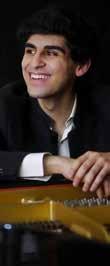
Ozel has performed with orchestras such as the Cleveland Orchestra, Jacksonville Symphony Orchestra, Minnesota Orchestra, RTE National Symphony and Boston Pops among others. As a soloist
Program notes by: Joseph
& Elizabeth Kahn
www.wordprosmusic.com
and as a chamber musician, Ozel has participated in several chamber music festivals including the the prestigious Marlboro Music Festival and Chamber Fest Cleveland. Other festival experiences include the International Mendelssohn Akademie Leipzig in 2018 as a Mendelssohn Fellow, taking masterclasses with Pavel Gililov and Matti Raekallio, and the Oxford Philomusica Piano Festival in 2015, where he had masterclasses with Ferenc Rados, Menahem Pressler, and Andras Schiff. He has also been selected to perform in masterclasses for Richard Goode, Paul Lewis, Mitsuko Uchida, Garrick Ohlssohn, Robert Levin, Hugh Wolff, Lang Lang and others.
Ozel is currently in the Master of Music program at New England Conservatory in Boston, MA where he has been studying with Wha Kyung Byun since 2014. He is represented by Concert Artists Guild, as one of the Ambassador Prize winners of their 2021 Victor Elmaleh Virtual Competition.
Evren Ozel, Piano
Blue Ridge Public Radio is honored to support the Asheville Symphony Orchestra.
bpr.org
BPR celebrates the arts and the role they play in enriching the quality of life in Western North Carolina.

50 ∙ www.AshevilleSymphony.org ∙ Fall 2022 Program Book


Asheville Symphony ∙ www.AshevilleSymphony.org ∙ 51

Take part in the festival! Opportunities to support the fourth Asheville Amadeus festival include participating as a partner, becoming a member of the 1756 Society, and more. Interested? Reach out to info@ashevillesymphony.org for more details on the Asheville Amadeus Festival.






ASHEVILLE AMADEUS IS BACK


This extraordinary ten-day celebration of arts and culture is one of the many reasons why the Asheville Symphony is regarded as one of our country’s most creative and innovative orchestras. It is with tremendous enthusiasm that we bring you the fourth Asheville Amadeus Festival starting on May 11 through May 20, 2023, this year celebrating the many shades of Americana, from bluegrass, jazz, and classical to pop, rock and folk. More festival details are on the way... Keep an eye on your inboxes and mailboxes this winter.
This season, we welcome the world’s biggest name in bluegrass and traditional music to the Asheville Symphony stage as Festival Headliner: banjo legend, Béla Fleck. Performing his The Imposter concerto for banjo and orchestra with the ASO at our grand festival finale on May 20 and collaborating with the Asheville Chamber Music Series to perform his banjo quintet, Night Flight Over Water, Béla’s participation in this


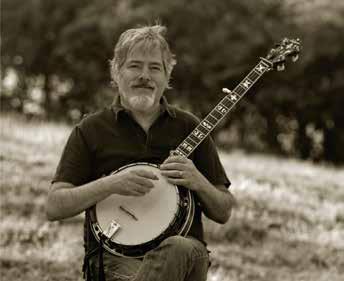
year’s festival will make for a truly Appalachian musical experience. Music education will also be a centerpiece of Béla’s residency in Asheville, as he joins forces with Asheville Symphony Youth Orchestra and the ASO in a performance for more than 4,000 5th graders in Buncombe County!
Opening this year’s Amadues Festival is multi-instrumentalist Kishi Bashi, a folk-infused, cinema-inspired artist known the world over for his cross-genre and multi-disciplinary approach to music making.
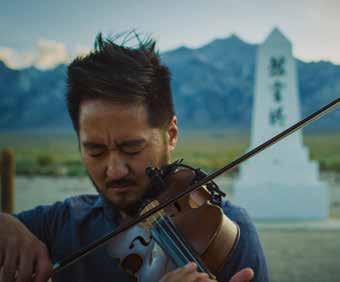
Kishi Bashi recently performed with the Seattle, Virginia, and Oregon Symphonies, and was featured in Ben Folds’ DECLASSIFIED series with the National Symphony Orchestra. Now, on May 13 as part of the festival’s opening weekend, he will join forces with the Asheville Symphony on its final ALT ASO concert of the year at Salvage Station on the banks of the French Broad River.
Symphonettes




Asheville
∙ www.AshevilleSymphony.org ∙ 53
Symphony
SY M P H ON Y
A SHEVILLE
CHORUS
Givens




54 ∙ www.AshevilleSymphony.org ∙ Fall 2022 Program Book
enriches our culture and our lives, promoting fulfillment and connection.
Music
Estates, a Life Plan Community, values the arts as an essential component for improving the lives of older adults along with life-enhancing services and a plan for healthcare. Learn more about Arts & Culture at Givens Estates by scanning the QR code or by visiting givensestates.org Improving Lives Music takes your ears on a journey across time and space. Let Kathryn Theodore Travel Advisors take the rest of you. Whether it’s cruising along the beautiful Blue Danube, visiting the theaters of New York City or diving deep into the folklore of the world’s cultures, we deliver behind-the-scenes access and VIP experiences. Just as the Asheville Symphony captures the spirit of a piece, we capture the essence of a place, immersing you in your destination for an unforgettable adventure. Contact Kathryn Schutz: (800) 322-9481 | kathryn@largaytravel.com The song of the open road is calling
Food & Beverage Partners















Many of Asheville’s greatest local businesses are those that serve the best food and drinks! Your Asheville Symphony is proud to partner with some of Asheville’s best restaurants, breweries, bars, and more. They serve Symphony patrons all year long; now they are doing more by supporting the Symphony as advertisers and sponsors.

Visit our Food & Beverage Partners to support your Symphony, and send these partners our love when you visit their establishments!
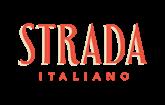
Do you work at or own a local restaurant or bar and want to be on this list? Contact Director of Development Jessica May at (828) 318-8181 or jcmay@ ashevillesymphony.org



MUSIC SPONSORS LIST
spirit animal beverages




Asheville Symphony ∙ www.AshevilleSymphony.org ∙ 55
20 15
copper crown
Season & Concert Sponsors
























Drs. Joanne & Tom Parker
Season & Concert Sponsors are critical to the Asheville Symphony’s success each year. Sponsors support a variety of key Symphony offerings including events, ALT ASO performances, special projects, guest artists, multi-day festivals, concert series, donor events, and even an entire season.

Henry
David
Thank you so much to the individuals, foundations, and businesses who support the Asheville Symphony and recognize the importance of arts organizations in our community.


Olivia
With options ranging from $250 to more than $25,000, sponsorship is a great way to partner with your Asheville Symphony. Each sponsorship package includes benefits custom tailored to your needs or the needs of your business. If you would like to see your name or business on this list of philanthropic individuals and businesses, contact Director of Development Jessica May at (828) 318-8181 or jcmay@ ashevillesymphony.org.
56 ∙ www.AshevilleSymphony.org ∙ Fall 2022 Program Book Asheville Symphony Supporters $ 25 , 000 + $ 10 , 000 + $ 5 , 000 + MEDIA $ 3 , 000 +
OFFICIAL HOTEL OF THE ASHEVILLE SYMPHONY
OFFICIAL AUTOMOTIVE COMPANY OF THE ASHEVILLE SYMPHONY
A. LaBrun
& Pamela Lane
& Gary Zahler
in Memory of Katherine Armitage & Jack Jones
Explore
Rich & Diane Byers
Buncombe County Tourism Development Authority
Max & Victoria Dreyfus Foundation
Robert & Mercedes Eichholz Foundation
in Honor of Sally Keeney
Mountaine Mort Jonas Katie & Phil Osborn
Timothy Butts & Susan Harrington Butts
SEASON MEDIA SPONSOR SEASON RADIO SPONSOR MEDIA PARTNER
Kevin Pasarilla & Jennifer Marlowe
Craig Allen & Julie Cowden
Phyllis Penley Patton
Donald Gavin & Jayne Schnaars
Lynne & John Eramo
This project was supported by the North Carolina Arts Council, a division of the Department of Natural and Cultural Resources.
Asheville Symphony Supporters
The Asheville Symphony Board of Directors, staff and musicians want to extend our deepest appreciation to our patrons. We are delighted to present this exciting and innovative 2022-2023 season, with more 2023-2024 plans to come — all thanks to your support.
Your gifts cultivate the next generation of music lovers by supporting our Music in the Schools program, the Young People’s concert and our spectacular Asheville Symphony Youth Orchestra!
Your gifts sustain our vibrant music community by allowing us to be one of the largest employers of performing artists in WNC; we are proud we are able to employ and retain the area’s most highly trained and talented musicians!
Your gifts strengthen the local economy by creating jobs and attracting home owners. The Asheville Symphony is a source of great community pride and your support ensures we continue our positive development trajectory!
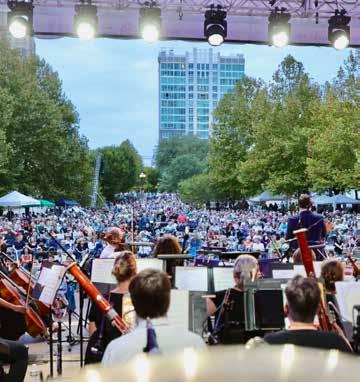
To learn more about supporting the Asheville Symphony please contact Jessica May, Director of Development at (828) 318-8181 or jcmay@ashevilleysmphony.org.
January 1, 2022 - August 8, 2022*
ASO Supporters
SEASON UNDERWRITERS
($25,000+)
Asheville Symphony Guild
Blue Spiral 1
Flow Volkswagen Porsche Audi of Asheville
iHeart Media, Inc.
Kimpton Hotel Arras
Henry A. LaBrun
David and Pamela Lane
North Carolina Arts Council
Drs. Joanne and Tom Parker
COMPOSER CIRCLE
($10,000-$24,999)
Michael and Catty Andry Anonymous
Asheville Citizen Times
Asheville Symphony Symphonettes
Audrey Love Charitable Foundation
Mr. Thomas C. Bolton
Timothy Butts and Susan Harrington Butts
Diane and Rich Byers in memory of Katherine Armitage and Jack Jones
The Chaddick Foundation
Max and Victoria Dreyfus Foundation
Explore Asheville
Lynne and John Eramo
Dr. Bolling Farmer
Bill and Nancy Gettys
Helle Creative
Highland Brewing Company
Hi-Wire Brewing
Keith Keener
Gerald and Nancy Kitch
Jim and Mary Kirby
Jill and Joe Lawrence
Barbra and Keith Love
William McKenna and Suzanne Landis
The Payne Fund
Bob and Martha Pierce in memory of Dr. Elizabeth Pierce Litteral
Robert & Mercedes Eichholz Foundation
Richard Schaffer and Anastasia Bartlett
James S. Thompson
Olivia and Gary Zahler
CONDUCTOR CIRCLE
($7,500 - $9,999)
Mary and Jack Anderson
Diana Bilbrey
Gene and Lee Casey
Hatchworks Coworking
Amy Loether
Carol and Hugh McCollum
Ed and Cindy Towson
ORCHESTRA CIRCLE
(5,000-$7,499)
Anonymous
Awaken Skin & Body
Gene and Lee Casey
Clover CBD Dispensary
George and Kathy Dambach
Gan Shan West
Debbie Green
Rhonda and Marcus Grimes
HomeTrust Bank
Kathryn Theodore Travel
Dr. and Mrs. Ralph C. Loomis
Asheville Symphony ∙ www.AshevilleSymphony.org ∙ 57
McGuire Wood & Bissette
Mountaine Mort Jonas in honor of Sally Keeney
Northwestern Mutual
Jennifer Marlowe and Kevin Pasarilla
Phil and Katie Osborn
Sarah Van Gunten
BENEFACTOR

($2,500 - $4,999)
Anonymous
Craig Allen and Julie Cowden
Brad and Diane Arnold
Meredith Balgley and Erik Bendix
The Blackbird Restaurant
Charles and Beverly Briedis
Margaret Butler
Randy and Martha Carson
Charles and Patricia Sloan Clogston
Crawley, Lee and Company, P.A.
Dr. John and Wendy Cuellar
John and Suzie Donahoe
D.R. Horton
Kathryn and Harry Durity
Nancy and Ron Edgerton
Donald Gavin and Jayne Schnaars
Richard and Yolanda Hall in memory of Rikki Hall
Bill and Kitty Hunt
Jon and Ann Kemske
Ann and Jerry McLellan
Russell and Ladene Newton
Jim Reeves
Morgan Stanley
Gary and BA Schenk
Bill Schulz and Odile Perrenoud
Maurice and Bonnie Stone
Van Winkle Law Firm
WNC Bridge NOW
Hank Young
IMPRESARIO
($1,000-$2,499)
Anonymous
Don and Nancy Ackermann Cole
Dr. and Mrs. Luther Barnhardt
Blue Ridge Public Radio
Lucy and Kirk Borland
Ed and Donna Broadwell
Tony McLean Brown in memory of Mr. and Mrs. Bill Burton
Bill and Clarita Burton
Darko Butorac
Dr. Nancy J. Cable
Lois S. Carlson and Jerome Mrowca
Karen L. Cianciulli
Douglas and Louisa Combs
John and Jeanne Condren
Daniel and Caroline Crupi
Jurgen and Leslie Dierks
Marvin and Patricia Eargle
Richard and Bridget Eckerd
John and Marsha Ellis
Dr. Alan and Suzanne Escovitz
John and Suellyn Felker
Betty Fox
Adarrell Gadsden and Marcie Ownbey
Judy Galloway
in memory of Don Galloway
Neil and Cindy Garroway
Michael J. Grillot
Fred and Cindy Groce
Dr. and Mrs. Heinz K. Grohs
Sam and Robin Harben
Robin and Mark Hayes
Jill and Dwight Healy
Robert and Linda Hollis
Jennine Hough
Inez Hullinger Redman in memory of Jack Redman
Stan Ingber and Lauren Robbins
Anne Jarema and Cliff Albertson
Randall and Mary Johnson
Debbie Lee
Mr. and Mrs. Paul Lerwick
John and Janet Long
Sue and George Luther
Dr. and Mrs. Carlo Mainardi
Anne McKenzie
Osada Construction LLC
Ralph Protsik and Susan Wolin
Kitti Reynolds
Sabrina and Isaac Rockoff
Martha G. Rowlett
David and Bettie Sousa
Irene and Michael Stoll
Margaret K. Storey
Gary and Jeanne Ann Stroebel
Ray and Patricia Strong
Jeff and Beth Sturkey in honor of Bill and Nancy Gettys
Thomas G. Tachovsky and Lynn G. Baird
The Asheville Symphony Chorus seeks to enrich and inspire our community through impactful performances of the masterworks of choral music. This year, the Asheville Symphony Chorus and the Asheville Symphony Orchestra will combine forces for Masterworks 3: Night at the Opera (see page 36). Additional performances will be announced in the spring. The Asheville Symphony Chorus is also pleased to welcome Kyle Ritter as Interim Conductor. Please scan the QR code to the right for more information or visit www.ashevillesymphonychorus.com. Follow and like the Asheville Symphony Chorus on Facebook and Instagram for details on upcoming events.
58 ∙ Asheville Symphony Supporters
ASHEVILLE SYMPHONY SOCIETY AFFILIATE
ASO SUPPORTERS
Shirley Tenney and Paul Merriken
Jay and Carol Verneuil
Dr. and Mrs. Larry R. Versteegh
David and Dianne Worley
PATRON ($500-$999)
Anonymous
David and Sydney Atkinson
Peggy Baker and Margaret Small in memory of Louie Baker
Marion Boone
Buster and Karen Brown
Mr. and Mrs. William Brown
Gary and Patty Coleman
Virginia Craig
Sharron Davis
Mary Ellen Dendy and Aaron Dahlstrom
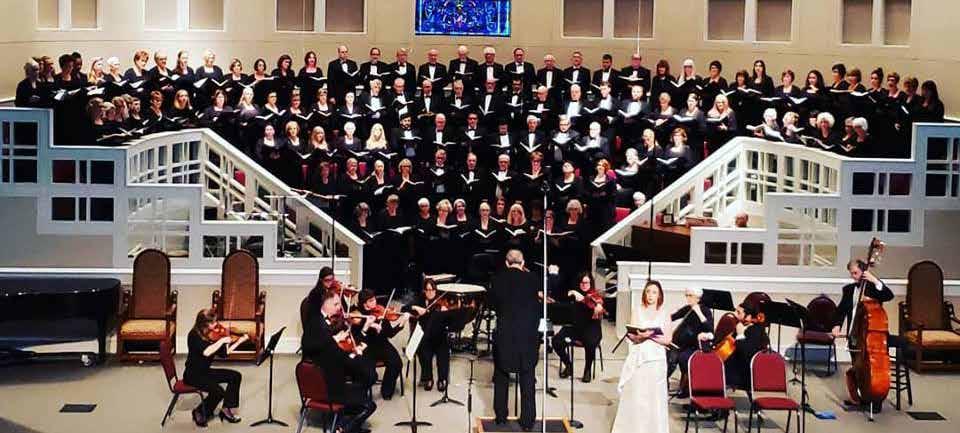
Lori Doerr
Drs. Louis Dwarshuis and Marilyn Kolton
William and Carol Falender
James and Linda Focareto
Robin and Gordon Gaiser
Peter and Jasmin Gentling
Clair Griffith and Geoffrey Mitchell in honor of Billie Marzullo
George and Elaine Goosmann
Anna Hayward
Fred and Heather Hudson
Pat and Doug Johnston
Gail Jolley
Elizabeth Justice
Jonas and Lauren Karlsson
Tom and Dian Leeper
Virginia and Drew Litzenberger
Diane and John Martin
Larry and Billie Marzullo
Jessica & David May
Lee and Merri McLean
Dwight and Shirley Oltman
Yvonne Smith
J. Howard and Honey Solomon
Donna and Randy Weast
Paul B. Williamson
Marla Woeckener
CONTRIBUTOR ($250-$499)

Anonymous
Mike and Lorna Anderberg
Charles and Stephanie Baer
Carole and Joel Cotter
Mack Day
William N. Dorfman, Ed.D.
Ron Goudreau and Martin Snyder
Al and Betsy Gumpert
Virginia W. Hayes
Dr. Earl Stephen Hunt and Mrs. Edeltraut Gilgan-Hunt
Bill Jacobs and Susan Posey
Marian and Thomas Jerdee
KeyBanc Capital Markets
Mary and Edward Kofron
Judy and Bill LaMée
Elfi LaPlante
Ferris L. Lyle
Chuck Lockwood and Patrick Ryan
Dr. Linda Lutz and Gary Ticknor
Henry and Elizabeth Mainwaring
Gail and Ron Manheimer
James H. McMillan and Carol H. Kaufman
Donna Robertson
James Storey and Janice Collins
Judy Watson
MEMBER ($100-$249)
Anonymous
Diana and Larry Armold
Mary Bachrach
Viiva Banzon & Robert Evans
Tom and Kay Beardsley
Treasure and Gary Beeson
Karen Boone
David and Ann Bottomy
Adlai and Karen Boyd
Rita Nilsen and Carl Brickman
Claude and Sallie Broach
Allan and Jean Brown
David G. and Lin Brown
Ellen Brown
Clinton Bugg and Jeff Nucey
Jim Cahill
Jane Caris
John Carpenter
Marshall Carter
Anne and Larry Clark
Bill and Meg Clontz
David and Cynthia Cobb
Asheville Symphony ∙ www.AshevilleSymphony.org ∙ 59 ASHEVILLE SYMPHONY SOCIETY AFFILIATE
ASO SUPPORTERS
Celebrate a loved one with a gift to your Asheville Symphony
Tribute gifts are a unique and thoughtful way to celebrate something or someone special while supporting a non-profit organization with a tax-deductible donation. These types of donations can be made to celebrate or commemorate any kind of occasion. Common attributions include anniversaries, birthdays, or significant life milestones. Additionally, tribute gifts can be made in memory of a loved one or on their behalf.
When you make a tribute gift, you will receive an acknowledgment letter indicating the tax-deductible amount of your gift. In addition to your own letter, the honoree or their family members will also receive a notification of your gift if you choose.
For more information, please contact Director of Development Jessica May at 828.318.8181 or jcmay@ashevillesymphony.org.
Visit page 62 to view recent tribute gifts.
Bishop Charles and Karen Crutchfield
Richard and Elizabeth Draper
Kristen Dusenbery
Martin and Ivy Dyckman
Kim Eiring
Don and Joy Erbes
Edward and Amy Euler
David and Ellen Feingold
Stephen and Jackie Finstad
James and Linda Focareto
Judy Fore
Ellenor Frelick

Mary Goodkind
Jeanie Graham
Scott and Sally Gregg
Paula J. Grillot
Amanda Hall and Robert Zeid
John and Elizabeth Hamrick
Kathleen Holmes
Nancy Houha
Barbara and Bill Hume
Sue Humphries Gibson Household
Henley Hurt
Thorunn Ivey
David & Eleanor Johnson
Daisy Karasek
Bob and Donna Kaye
Margaret Kelso
Theodore and Nancy Kennedy
Jess and Phyllis Key
Elaine Kiser
Karen Lachow
Bryan and Colleen LaPlante
Eric and Mala Lapp
Jana and Chris Lechner
Walter Leginski
Dr. Ken and Mrs. Marjorie Loken
James Losse and Ellen Haack
Dr. John and Xandra Manley
William D. and Linda Mashburn
Judith Mayer
Dr. and Mrs. Ben McCarty
John and Jansen McCreary
Ryan and Kelly McLellan
Gayle Miller
Elwood and Margaret Miles
Martha and Thomas Mills
Elizabeth Minor
Reid, Alyson, Ellis, and Tess
McCollum in honor of Carol McCollum
Charlie and Delores Norris
Francis Nullet
William O’Connell
Jane Okuma, Chris and Mika Gordon in memory of Lindley Garner
John K. Orr
Jeffrey and Lisa Owen
Lori Oxford and Alberto Centeno-Pulido
John Paar
Donald and Brenta Poole
Dr. and Mrs. H. Leonard Porter
Susan and Mike Portland
Kathleen Quinlan and Marc Parham
George and Donna Renfro
Holly Renfro
Symphonettes
The Asheville Symphonettes is a high school girls’ service group that has been serving the Asheville area since 2011. Exposing high schoolers to live symphony concerts creates a lifelong love and appreciation of classical music, and Symphonettes experience this while forging lifelong friendships and bettering their community. This season, Symphonettes will participate in a Lock In fundraiser in the fall and pair up with the Symphony Guild in the spring at the well known “Pass The Hat” event with proceeds from both events going to benefit the Symphony. The Symphonettes also serve as ushers for Asheville Symphony concerts and serve the community in a multitude of ways.
For Symphonette membership or funding inquiries, please contact Gretchen Brown at gbgb123@gmail.com.
60 ∙ Asheville Symphony Supporters ASHEVILLE
SYMPHONY SOCIETY AFFILIATE
ASO SUPPORTERS
Don Roberts
Julene Reese Roberts
Barbara Robinson
Sherree Roller and David Janson
Evan and Susan Rosenberg
Frank Rutland
Sharon Sandel
Marcy and Michael Salemi
Clyde and Peggy Sawyers
Katherine and Robert Silvers
Gail and Nelson Sobe
Thomas Southwick
Mary Stuart
Bernard and Sue Stanek
Jan and Wayne Stanko
Eric Taylor
Janet Thatcher
Richard and Alyssa Weber
George Wilds and Steve Connell
Larry and Janie Wilson
FRIEND ($1-$99)
Erin Abernethy
Dr. Leanne Apfelbeck and Ms. Bonnie Snyder
Joe and Lynn Armour
Julian and Martha Biller
Elizabeth and Kemper Brown
Lana Burns
Nan Buschmann
Jackie Carden and Jane Dupont
Alexa and Rich Dann
Peter Wortham Hawes
Michael and Laura Hoskins
Drs. William and Sara Hoyt
Ralph and Sheryl Husby
Katherine and Jon Karraker
Philip and Kathleen Leftwich
Lynn Lederer and Leslie Long
Barbara Mayer
Stephanie Milani
Frederick W. Selph
Cathy Stryker
Susan Novak Wagner
Norman and Janet Weeks
Barbara Witt
Andrew and Virginia Woelflein
David and Dianne Worley
Rich Wyde and Angela Branch
* This list includes new donations and previously unrecorded donations from January 1, 2022 to August 8, 2022. Every effort has been made to ensure the accuracy of this list, however, if you note an omission or an error please contact Director of Development Jessica May at (828) 318-8181 or jcmay@ashevillesymphony.org. Thank you!

Matching Gifts
Many companies offer a matching gift program for employee (and retiree!)
charitable donations – this can double or triple your gift! Check with your company’s human resources or payroll department to see whether it offers a matching gift program.
The Asheville Symphony extends appreciation to the following companies who have recently matched donor gifts to our programs:
AIG
Boeing Eaton Corporation
IBM Corporation
McMaster - Carr Supply Company

Prudential Financial Inc.
State Farm Companies Foundation
Steelcase Foundation
Shell Oil Company Foundation
To learn more please contact Jessica May, Director of Development at (828) 318-8181 or jcmay@ashevillesymphony.org
Asheville Symphony ∙ www.AshevilleSymphony.org ∙ 61
ASHEVILLE SYMPHONY SOCIETY AFFILIATE ASO SUPPORTERS
In memory of Louie Baker
Peggy Baker and Margaret Small
In memory of Jocelyn
Baumgarten

Gayle Miller
In memory of George Bilbrey
Diana Bilbrey
In honor of Mr. and Mrs.
Bill Burton
Tony McLean Brown
In memory of Don Galloway
Judy Galloway
In memory of Lindley C. Garner
Mary Bachrach
Rich Wyde and Angela Branch
Russell and Margaret Gerleve
Jane Okuma, Chris and Mika Gordon
In honor of Bill and Nancy Gettys
Jeff and Beth Sturkey
In honor of Albert Allen Gumpert
Joe and Lynn Armour
In honor of Ginny and Gary Hunt
Amy and Ryan Haldeman
In memory of our son, Rikki Hall
Richard and Yolanda Hall
In memory of Katherine Armitage and Jack Jones
Diane and Rich Byers
In honor of Sally Keeney
Mountaine Mort Jonas
In honor of Ralph and Mary Keil
Buster and Karen Brown
On behalf of Gerry and Nancy Kitch
Barbara and Bill Hume
In memory of Dr. Elizabeth
Pierce Litteral
Bob and Martha Pierce
In memory of Annette Luethold
Al and Betsy Gumpert
In honor of Billie Marzullo
Clair Griffith and Geoffrey Mitchell
In honor of Carol McCollum
Reid, Alyson, Ellis and Tess McCollum
In celebration of Chris McNabb
Salette Gressett
In memory of Ann Rennard
David and Cynthia Cobb
Gary and Patty Coleman
Mary Grace Rennard
Brett and Cathy Wingo
In honor of Cynthia Roop
Ruth Sieber Johnson
In memory of Karl and Shirley Quisenberry
Richard and Yolanda Hall
In memory of Jack Redman
Inez Hullinger Redman
The Asheville Symphony Guild proudly supports the Asheville Symphony and the part it plays in our community through volunteer support and fundraising. In the more than 50 years since it was founded, the Guild has raised over $1 million to support the Asheville Symphony Orchestra.
If you love music and want to form a deeper connection to other music-lovers and to the Asheville Symphony, we invite you to join the Guild today! For more information or to join the Guild, visit ashevillesymphonyguild.org or scan the QR code to the right.
62 ∙ Asheville Symphony Supporters
ASHEVILLE SYMPHONY SOCIETY AFFILIATE
ASO SUPPORTERS
Tribute Gifts
Support your Symphony’s Annual Fund
Asheville’s passion for music helps shape the quality of our community and inspires our musicians and the guest artists who work with us. This passion culminates in the incredible live experience we offer people of all ages and backgrounds through our programs, inside and outside of the concert hall.
We are only able to achieve our mission because of the generous support of people like you who are passionate about music, education and their community. Ticket revenue covers less than half of the symphony’s operating cost.
Help us set the stage for the present and future of classical music by making a contribution to the Annual Fund.

Visit AshevilleSymphony.org or contact Director of Development Jessica May at 828.318.8181 to make a donation to this season’s Annual Fund today.
MUSICAL FEASTS: YOUR SOCIAL AGENDA AWAITS!
From garden parties to barbecues to elegant evenings — join the Guild and experience these fun Musical Feasts while supporting our Symphony!
Supporting your Symphony can bring you closer to the music and provide unique and exclusive benefits! Check out some highlights below, but visit www.AshevilleSymphony.org for the full list of donor benefits for Annual Fund supporters.
Free parking... even in Downtown Asheville! ($1,000+ to the Annual Fund)
Inclusion on event signage and promotional materials (sponsorship options start at $250)
VIP experiences including exclusive invitations to donor events with guest artists, musicians, and fellow music lovers (starting at $500+)
Unprecedented access to the Asheville Amadeus Festival plus the option to purchase festival tickets in advance (1756 Society membership starts at $1,756)
Curious about our full benefit offerings? Interested in customized benefits for you or your business? Contact Director of Development Jessica May at 828.318.8181 or jcmay@ashevillesymphony.org for more details.
GUILD-SUPPORTED MUSIC EDUCATION PROGRAMS
The Guild introduces more than 7,000 elementary school children to classical music each year through the Music in the Schools program. The Guild also helps support our wonderful Asheville Symphony Youth Orchestra.
GUILD GATHERINGS: SHARE THE LOVE!
From our Fall Potluck to the annual May Gathering, Guild members enjoy getting together to share their love of music and our wonderful Symphony.

Asheville Symphony ∙ www.AshevilleSymphony.org ∙ 63 ASHEVILLE SYMPHONY SOCIETY AFFILIATE
ASO SUPPORTERS
>> >> >> >>
Friends of the ASYO
Anonymous
Mike and Lorna Anderberg
Mary and Jack Anderson
Michael and Catty Andry
Charles and Stephanie Baer
Diana Bilbrey
Mr. Thomas C. Bolton
Bill and Clarita Burton
Tim and Susan Harrington Butts
Gene and Lee Casey
Sylvia Cassel
James and Patricia Cooley
Daniel and Caroline Crupi
Dr. John and Wendy Cuellar
Jerry and Diane Cunningham
Kamini and Jagdishbhai Desai
Erin and Tom Doyle
Amanda Durst
Kim Eiring
Nancy and Ron Edgerton
Lynne and John Eramo
Dr. Bolling Farmer
Polly S. Feitzinger
Stephen and Jackie Finstad
Betty Fox
Ellenor Frelick
Adarrell Gadsden and Marcie Ownbey
Robin and Gordon Gaiser
Bill and Nancy Gettys
Salette Gressett
Al and Betsy Gumpert
Kate Townsend and Michael Hawkins
Sue Holliday
Dr. Earl Stephen Hunt and Mrs. Edeltraut Gilgan-Hunt
Bill and Kitty Hunt
Ruth Sieber Johnson
Keith Keener
Margaret Kelso
Jon and Ann Kemske
Jim and Mary Kirby
David and Pamela Lane
Jill and Joe Lawrence
Debbie Lee
Doris and Ralph Loomis
Barbra and Keith Love
Sue and George Luther
Henry and Elizabeth Mainwaring
Jessica & David May
Carol & Hugh McCollum
Anne McKenzie
Dagi Murphy
Russell and Ladene Newton
Nicole Norian and Robert Dennis
Jeffrey and Lisa Owen
Drs. Joanne and Tom Parker
Morgan and Barbara Pearson
Kathleen Quinlan and Marc Parham
Sarah and R. Rah
Scholarships for ASYO Students
Kris-Kel for Kids Fund
Given by Jerry and Diane Cunningham
Philharmonia Scholarship
Given by Keith Keener
Drs. Joanne and Tom Parker
Scholarship Fund
Given by Drs. Joanne & Tom Parker
NOW Fund Scholarship
Through the WNC Bridge Foundation
Ann Rennard Memorial Scholarship
Given by the families of her loving siblings:
William Worthington and Carole Spears
James and Patricia Cooley
Janet and Robert Shaw
Sarah and R. Rah
Brett and Cathy Wingo
Carl A. Worthington, Sr.
Carl A. Worthington, Jr. & Deborah Worthington
John Worthington
Kurt Worthington and Jennifer Brodie
Donna Robertson
Cynthia Roop and Dr. Brian Tinkel
Mary Ropson and Mary Streckenbach
Janet and Robert Shaw
Irene and Michael Stoll
Kate Townsend and Michael Hawkins
Ed and Cindy Towson
Sarah Van Gunten
Ted and Karen Wallace Meigs
Larry and Janie Wilson
Brett and Cathy Wingo
Carl A. Worthington, Jr. and Deborah Worthington
Carl A. Worthington, Sr.
John Worthington
Kurt Worthington and Jennifer Brodie
William Worthington and Carole Spears
Olivia and Gary Zahler
At the ASYO, we believe that all students deserve access to incredible musical experiences regardless of their economic circumstances. These scholarships have been created to assist ASYO participants with tuition, ensuring that all students have equal access to the best musical training and resources that Asheville has to offer. Thank you to our generous donors!
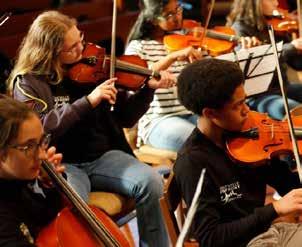
64 ∙ Asheville Symphony Supporters
ASO SUPPORTERS
The Asheville Symphony Youth Orchestra program serves more than 150 student musicians throughout the greater Asheville area. The program consists of two string orchestras, one symphony orchestra, and one percussion ensemble. Students also have the opportunity to participate in string, woodwind, and brass small chamber ensembles. Throughout the year, students participate in masterclasses, retreats, workshops, and social events.
Each group of young musicians receives the highest quality of orchestra training from the region’s most respected professional conductors and musicians. ASYO members gain a strong sense of discipline, increased confidence, build lifelong friendships, and a deep appreciation for the arts.
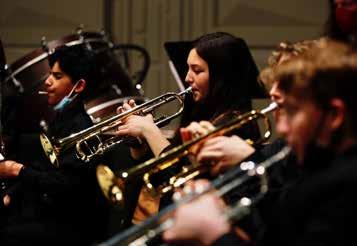
WINTER CONCERT
December 5, 2022 at 6:30 p.m.
• Asheville High School
SPRING CONCERT
April 24, 2023 at 6:30 p.m. • Asheville High School
ASHEVILLE AMADEUS FESTIVAL
May 19, 2023 • Thomas Wolfe Auditorium
The advanced Youth Orchestra will have the opportunity to perform during the Asheville Amadeus Festival with a side-by-side concert featuring professional Asheville Symphony musicians and festival headliner Béla Fleck.
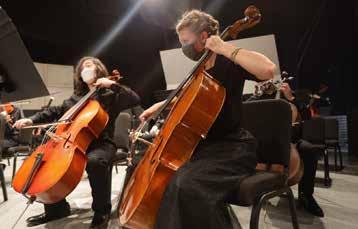
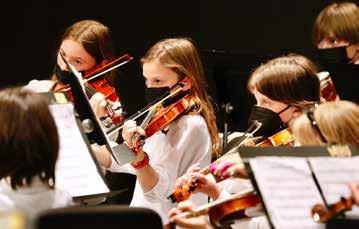

For more information about the ASYO, including how to join and how to support, please visit www.ashevillesymphony.org/asyo
A special thank you to Drs. Joanne and Tom Parker for their generous support for the ASYO this season. Their financial support will positively enhance music education for hundreds of students across Western North Carolina by providing scholarships, access to instruments, and opportunities for students to engage in chamber music and our annual retreat.

Asheville Symphony ∙ www.AshevilleSymphony.org ∙ 65
Music Sponsors
Michael and Catty Andry
Diana Bilbrey in memory of George Bilbrey
Darko Butorac
Timothy Butts & Susan Harrington Butts
Dr. Nancy J. Cable
Gene and Lee Casey
Charles and Patricia Sloan Clogston
Carole and Joel Cotter
Daniel and Caroline Crupi
George and Kathy Dambach
Mary Ellen Dendy and Aaron Dahlstrom
John and Suzie Donahoe
Amanda Durst and Jason McCoy
Lynne and John Eramo
Dr. Alan and Suzanne Escovitz
Adarrell Gadsden and Marcie Ownbey
Robin and Gordon Gaiser
Donald Gavin and Jayne Schnaars
Debbie Green
Richard and Yolanda Hall in memory of our son, Rikki Hall
Sam and Robin Harben
Bill and Kitty Hunt
Gail Jolley
Jim and Mary Kirby
John and Janet Long
Barbra and Keith Love
Sue and George Luther
Jessica and David May
Larry and Billie Marzullo
Ann and Jerry McLellan
Carol and Hugh McCollum
Ralph Protsik and Susan Wolin
Kitti Reynolds
Samsel Architects
Richard Schaffer and Anastasia Bartlett
J. Howard and Honey Solomon
Barbara and Marty Stickle
Irene and Michael Stoll
James S. Thompson
Sarah Van Gunten
Marla Woeckener
Hank Young
We believe music matters. We believe it changes lives.
Here’s how we make music with your dollars:
$20,000
Covers the cost of presenting one Young People’s Concert for school children
$7,500
Pays the fees and travel for one guest soloist
$5,000
Allows for one workshop for the Asheville Symphony Youth Orchestra
$2,500
Covers the cost of renting and moving a concert grand Steinway into our venue for Piano Recitals
$1,300
Covers the purchase of music for a single Beethoven symphony
$1,000
Provides tuition scholarships for ten Youth Orchestra students
$750
Allows us to offer one Masterclass for emerging young musicians with an esteemed guest soloist
$375
Pays for one Music in the Schools program (one quintet, one school, one hour)
$170
Covers the cost of orchestra folders for ten Youth Orchestra students
Donations to the Symphony’s Annual Fund support all of these programs and more. To learn more please contact Jessica May, Director of Development (828) 318-8181
jcmay@ashevillesymphony.org
66 ∙ www.AshevilleSymphony.org ∙ Fall 2022 Program Book
Support Your Symphony
Asheville Symphony Supporters




Asheville Symphony ∙ www.AshevilleSymphony.org ∙ 67 a special occasion. This is list of our current 2022-2023 Music Sponsors as of August 8, 2022, but many pieces on our programs are still in need If you are interested in sponsoring a piece of music, reach out to Director of Development Jessica May at (828) 318-8181 or jcmay@ Shawna Hoffert, DDS Restore smile Red Maple Dental SmileAsheville.com | 828-252-7304 If you’re considering dental implants, call or visit our website today. your dental implants. with expert

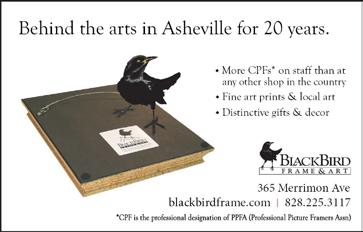












68 ∙ www.AshevilleSymphony.org ∙ Fall 2022 Program Book FIND YOUR WAY TO FLAVOR!® Herbs & Spices • Exotic Teas • Gourmet Gifts THE SPICE & TEA EXCHANGE® OF ASHEVILLE 46 Haywood Street, #101 | Asheville, NC 28801 | (828) 505-7348 | spiceandtea.com/asheville Discover more at (888) 529-2962 AboutActs.com/Symphony flix Find your light At Tryon Estates, a premier Acts Retirement-Life Community in the foothills of the Blue Ridge Mountains, we believe the things you love should always get top billing. We take care of the worries, while you put life center stage. Discover a retirement you’ve always dreamed of. Call today.
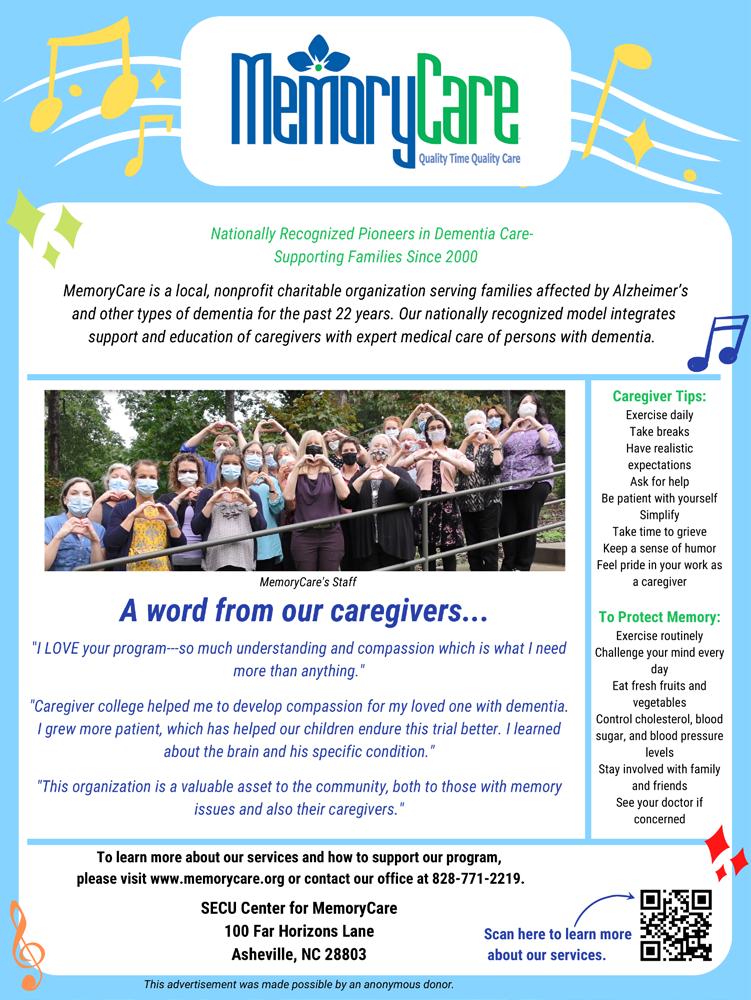
Asheville Symphony ∙ www.AshevilleSymphony.org ∙ 69



70 ∙ www.AshevilleSymphony.org ∙ Fall 2022 Program Book Morgan Stanley Private Wealth Management Is Proud To Support Asheville Symphony © 2022 Morgan Stanley Private Wealth Management, a division of Morgan Stanley Smith Barney LLC. Member SIPC PWM003B CRC 4867821 08/22 CS 9899356 The Andry-Harris Group at Morgan Stanley Private Wealth Management Michael Andry Family Wealth Director Senior Vice President Private Wealth Advisor 500 College Street Asheville, NC 28801 +1 828 250-8744 michael.andry@morganstanleypwm.com advisor.morganstanley.com/the-andry-harris-group N MLS#663185 L:3.625" L:10" 攀
Legacy Society Members
Dorel Abbott*
Don and Nancy Ackermann Cole
Jack Jones* and Katherine Armitage*
Mr.* and Mrs. Stephen Barden III
Dr. and Mrs. Luther Barnhardt
Mary* and Leland* Bartholomew
Kathy Bellizio
George* and Diana Bilbrey
Marion Bleyler*
Mr. and Mrs.* Thomas C. Bolton
Joyce Bost Hogan*
Mrs. Charles Butler*
Ken and Alma Chatfield*
Barbra* and Beirne* Chisolm
Mr. and Mrs. Gary Coleman
Nancy Crosby
Dr. and Mrs. John Cuellar
Robert DiDiego
Lori Doerr
Mr. and Mrs. David Dolan
Drs. Joyce and Lawrence* Dorr
Mrs. C.H. Elmslie
Robert and Jeanne Etter
Dr. Linda Sokalski Farrell
Dr. Bolling Farmer
Francis Fee
Doris Kistler and Fred Wightman
William and Nancy Gettys
Lindley Garner* and Mary Goodkind
Mr. and Mrs. George Goosman
Paula J. Grillot
Mr. and Mrs. Steven Hageman
Dr. and Mrs. Matthew Hahner
Eleanor Hall*
Dick and Yolanda Hall
Virginia and Emmet* Hayes
Anna and Anthony* Hayward
Bill and Kitty Hunt
Bill Jacobs and Susan Posey
Pat and Doug Johnston
Mountaine Jonas
James Laird*
Christine Longoria
Dr. and Mrs. Carlo Mainardi
Mabel Marlsbury*
Mr. and Mrs. Arthur Mattson*
Carol and Hugh McCollum
Ann and Gerald McLellan
Ingeborg and Kenneth* Meeke
Fred Meyer
Russell and Ladene Newton
Arch and Zeffie Nichols*
Mr. and Mrs. David Pheil
Mary L. Powell Education Fund in memory of Beatrice Wells

Monte Richardson*
Ernest Rosenau*
Dr. and Mrs. Joel Rosenberg
William* and Carole Roskind
August Schmidt *
John Schuler*
Robert Sorton
Bonnie Stone
Norretta L. Taylor*
Edna Thompson*
Mr. and Mrs. Ed Towson
Albert and Lucia Ward*
Eleanor Weil Schulmon*
*Deceased
The Asheville Symphony Legacy Society recognizes people who have planned a gift to the Symphony in their will or estate plans. Speak to your financial advisor and contact Jessica May, Director of Development, to learn more about the Legacy Society: (828) 318-8181 or jcmay@ ashevillesymphony.org.
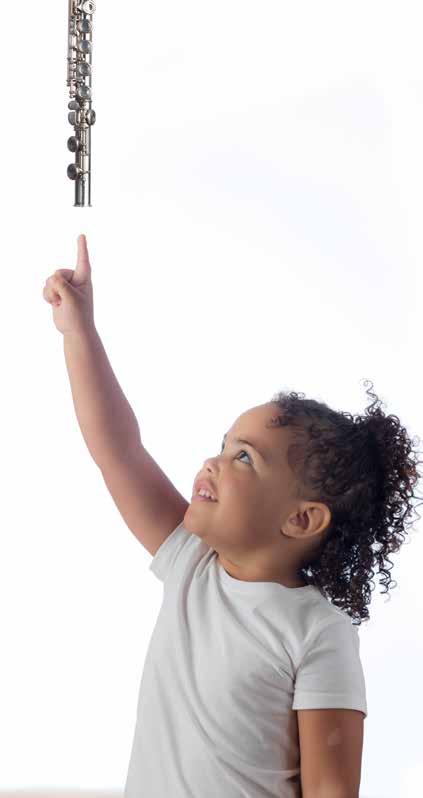
Tomorrow is listening. Will Isabella’s Asheville Symphony be the same vital part of the community as it is now?
Plan a gift today, so when tomorrow listens... she’ll hear you.
Asheville Symphony ∙ www.AshevilleSymphony.org ∙ 71
Asheville, North Carolina 800-284-1531 deerfieldwnc.org
to schedule a visit and discover a holistic approach to a joy-filled retirement.
Call
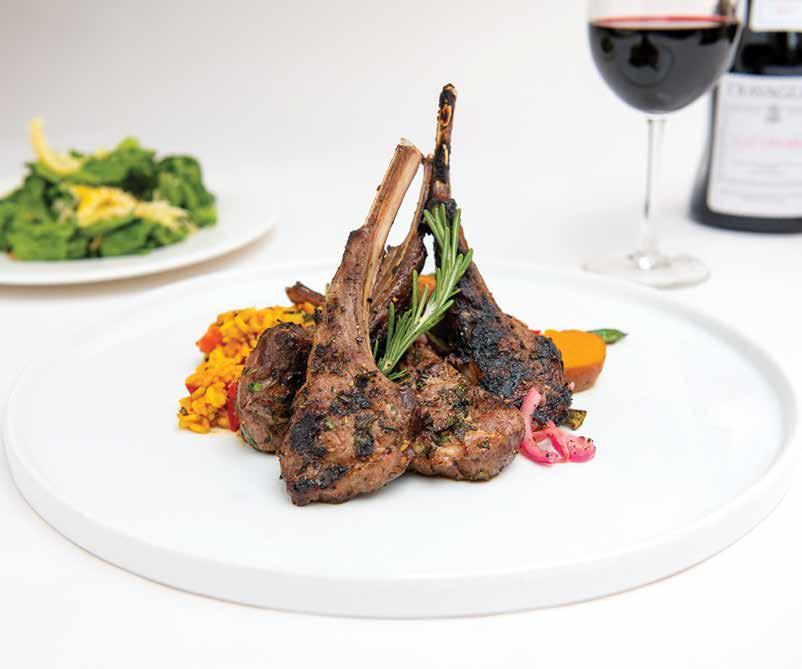




72 ∙ www.AshevilleSymphony.org ∙ Fall 2022 Program Book Encore. #1 SW Pack Square Downtown Asheville 828-254-0209 Bomba NC .com Downtown Asheville 828-252-9805 Salsas NC .com HectorsHotSauce.com Historic Grove Arcade 1 Page Ave #138 828-225-4133 Modestonc.com
Northwestern Mutual Kevin Pasarilla

Wealth Management Advisor
4 Vanderbilt Park Dr, Ste 350 828-210-3806

kevinpasarilla.nm.com
Northwestern Mutual Jennifer Marlowe

Growth and Development Director 4 Vanderbilt Park Dr, Ste 350 727-744-0352
jennifermarlowe.nm.com
Asheville Symphony ∙ www.AshevilleSymphony.org ∙ 73 07-1012 ©08-2022 The Northwestern Mutual Life Insurance Company (NM), Milwaukee, WI.
PLAN FOR TOMORROW, LIVE FOR TODAY.
07-1012 ©08-2022 The Northwestern Mutual Life Insurance Company (NM), Milwaukee, WI.
IF YOU LIVE FOR IT, WE’LL HELP YOU PLAN FOR IT.
Advertiser Index

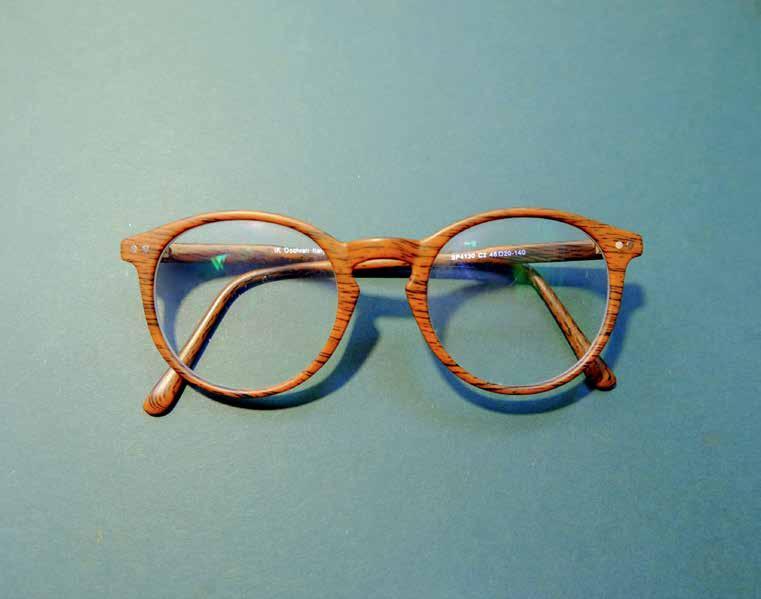

Advantage Direct 26 ALFIE BC Asheville Area Arts Council 35 Asheville Dental 3 Asheville Eye Associates 74 Asheville Symphony Chorus 58 Asheville Symphony Guild 62 Asheville Symphony Symphonettes 60 Asheville Symphony Youth Orchestra 64 Awaken Skin & Body 73 Biltmore Estate 12 The Blackbird 44 Blackbird Frame & Art 68 blue 70 Blue Ridge Public Radio 50 Blue Spiral 1 8 Celine & Co. 10 Citizen Times 6 Clover CBD Dispensary 51 Gillespie Dental Associates 19 Givens Estate 54 Gould Killian CPA Group, P.A. 10 Groce Funeral Home 74 Hatchworks Coworking 18 Helle Creative 33 Hi-Wire Brewing 41 Highland Brewing 15 HomeTrust 2 iHeart Media 4 Kathryn Theodore Travel Advisors 54 Kimpton Hotel Arras 34 McGuire Wood & Bissette Law Firm 16 MemoryCare 69 Mercy Urgent Care 68 Mission Health 75 Modesto 72 Morgan Stanley 70 Northwestern Mutual 73
Celebrating 61 years of eye care excellence in Western North Carolina THE BEST IN MUSIC, THEATRE, DANCE, COMEDY AND MORE ( 8 2 8 ) 2 5 7 - 4 5 3 0 • wo r t h a m a r t s . o r g Photo: Malevo • March 3 & 4 DOWNTOWN ASHEVILLE
MINIMALLY INVASIVE



After my dad was diagnosed with lung cancer, I answered a calling to be an oncology nurse. I know how challenging it is not only for cancer patients, but also for their families. Each day I care for entire families—because I know the positive impact I can have on their cancer journey simply by being by their side. ~
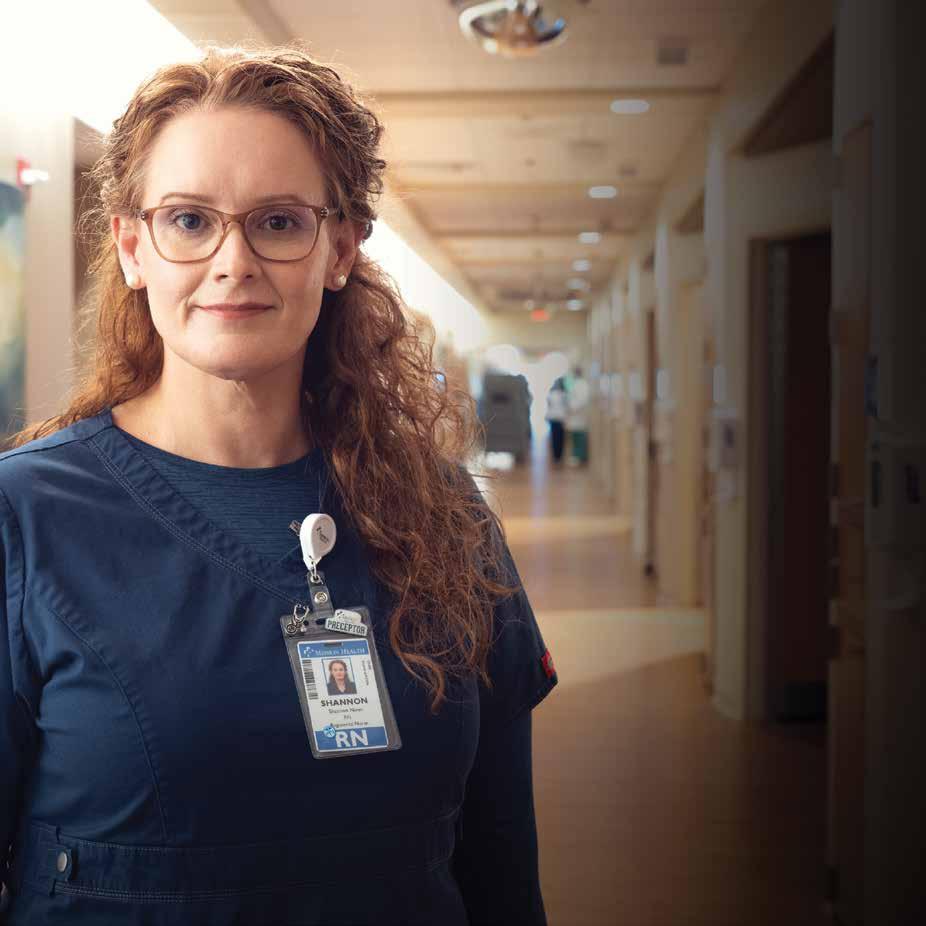
Asheville Symphony ∙ www.AshevilleSymphony.org ∙ 75
SHANNON,
TO
TO
missionhealth.org/mymission
Oncology Nurse DEDICATED
OUR PATIENTS. COMMITTED
OUR EMPLOYEES. Visit
C OM PASSIO N TH A T ’ S MY MISSION .
C M Y CM MY CY CMY K Mission Shannon Clinical Asheville Symphony SM3.pdf 1 6/29/22 3:04 PM
SURGERY. ACCESS TO SARAH CANNON RESEARCH TRIALS.


76 ∙ www.AshevilleSymphony.org ∙ Fall 2022 Program Book Asheville-based, Real Estate focused Private Debt Fund serving the Carolinas 19 Arlington Street Asheville, NC 28801 www.alfieloans.com 828-776-8632
ALFIE? ALFIE is a private debt fund established in 2015. Based in Asheville, NC, our fund works by pooling investor capital to provide short term construction and bridge loans to builders, developers, and real estate entrepreneurs in North and South Carolina. INVESTMENT PORTFOLIO? HOW DOES ALFIE FIT MY
ALFIE
INVEST LEARN MORE... BORROW
WHAT IS
An allocation to
can complement a traditional stock and bond investment portfolio. Our historically consistent returns have a low correlation with other investment options.




































































































 Johann Sebastian Bach (1685-1750)
Johann Sebastian Bach (1685-1750)









































































































